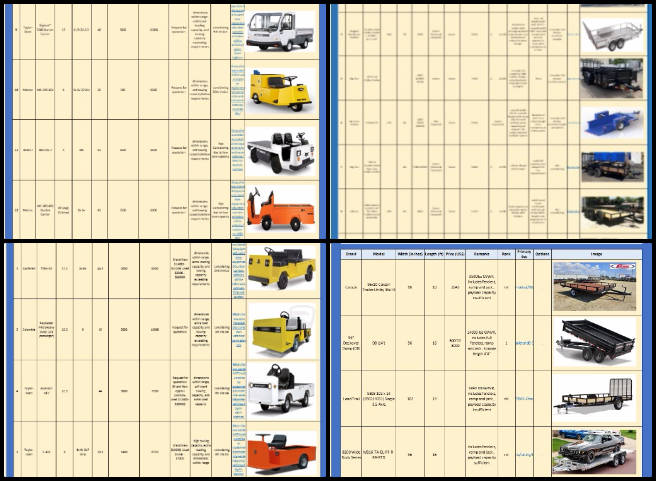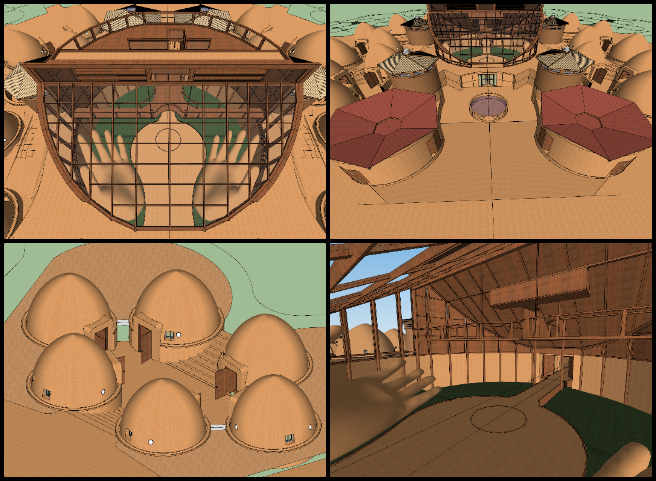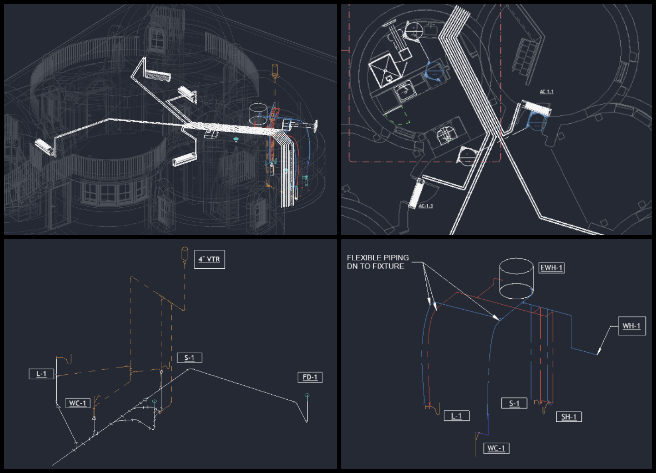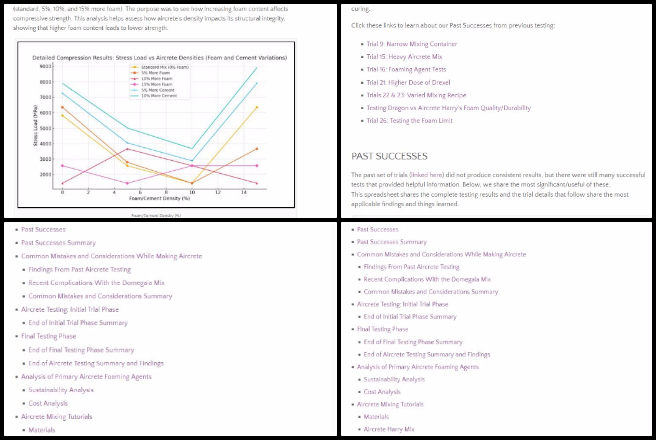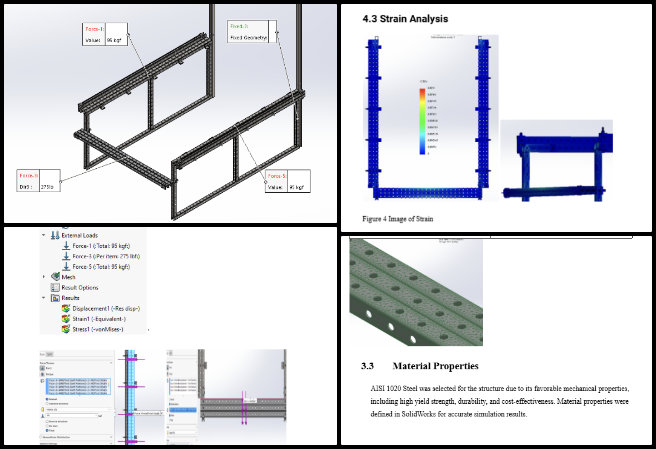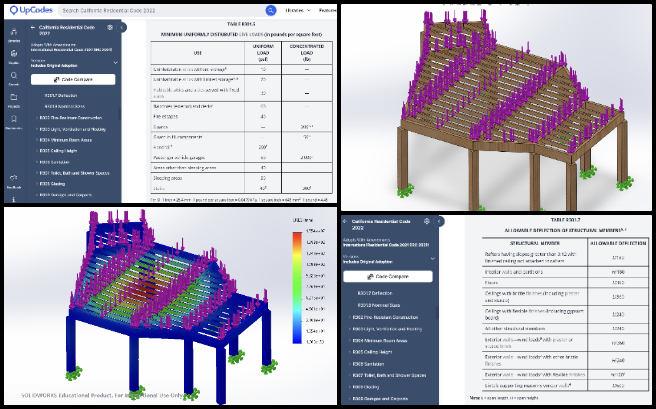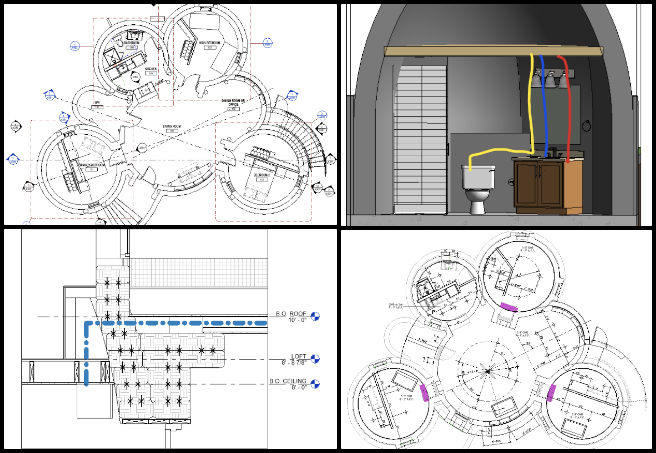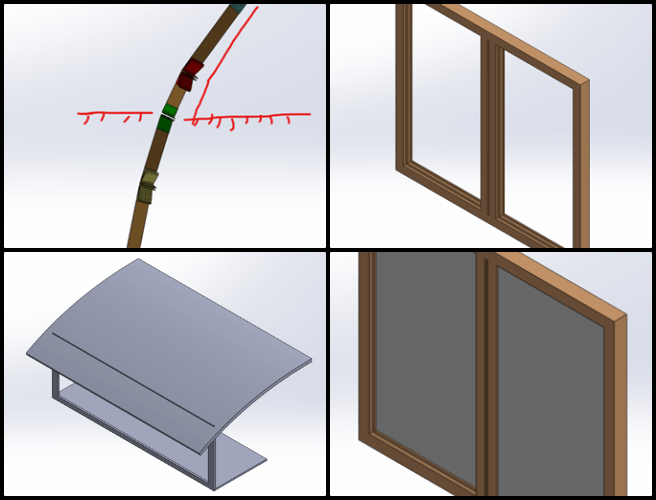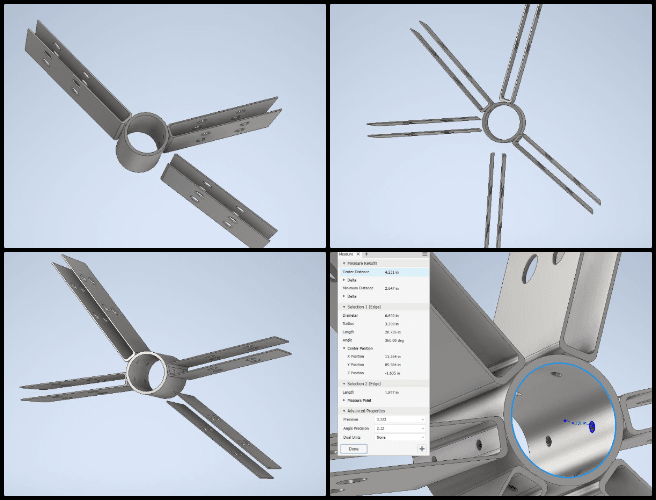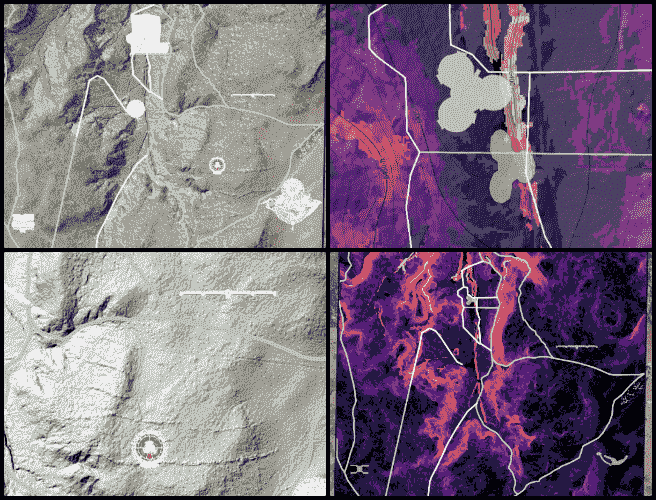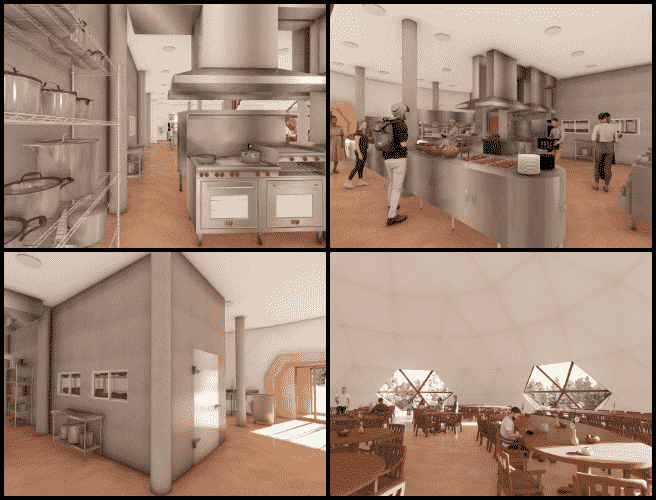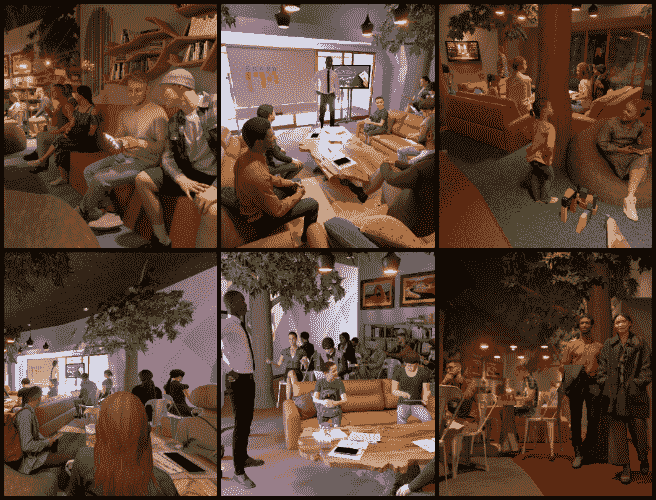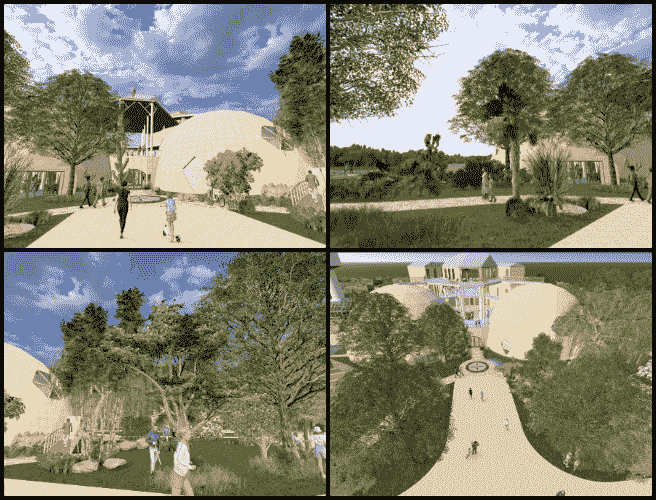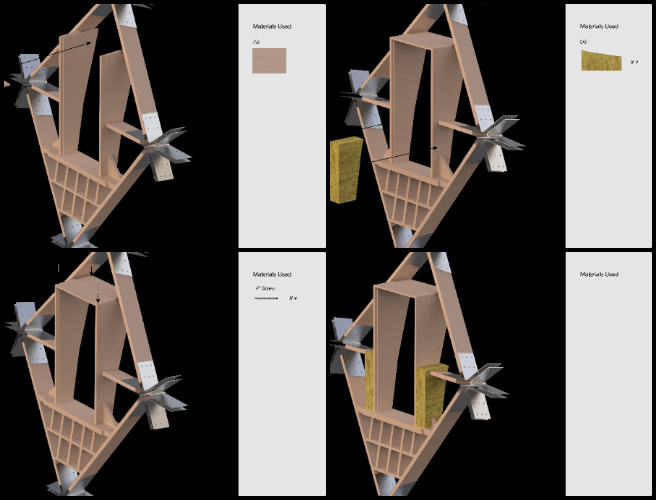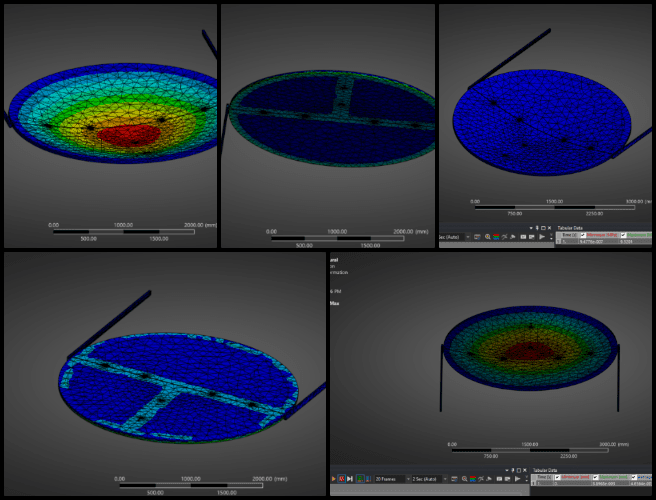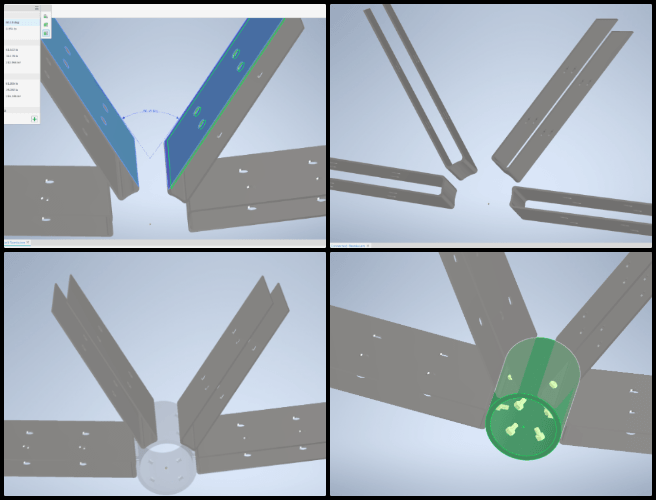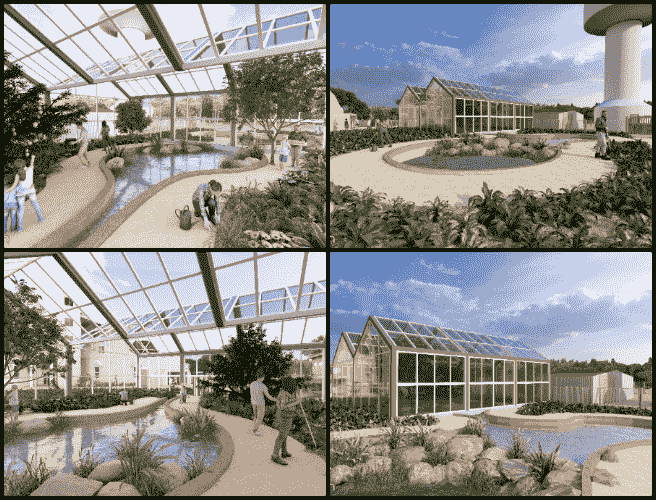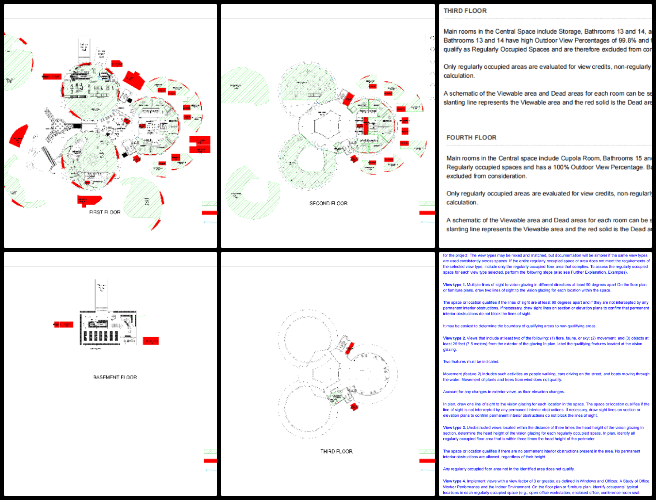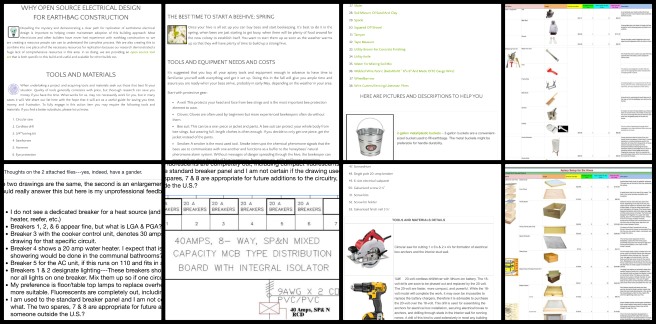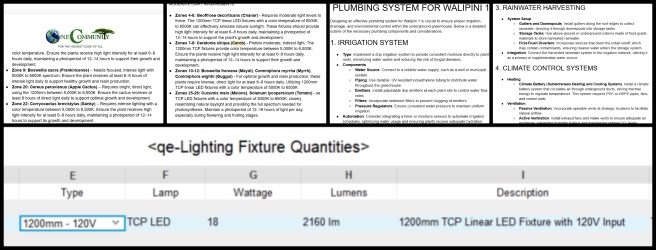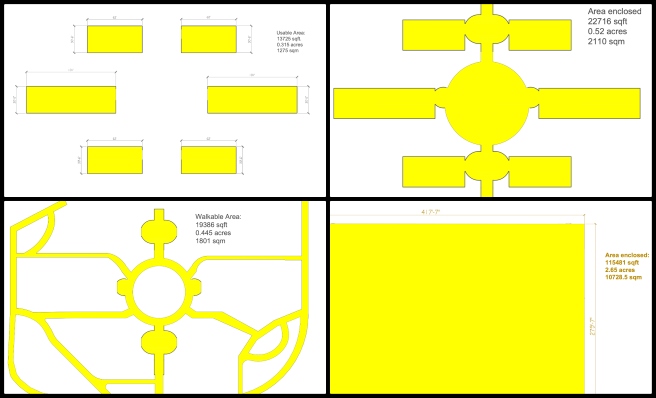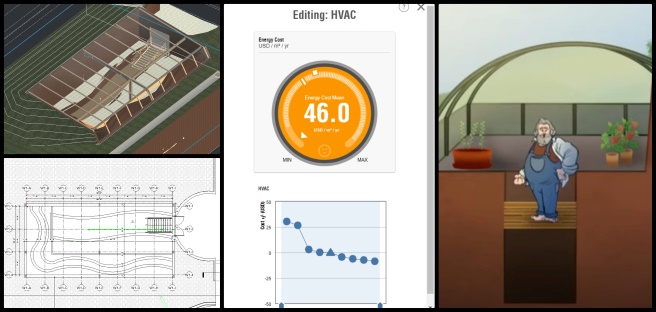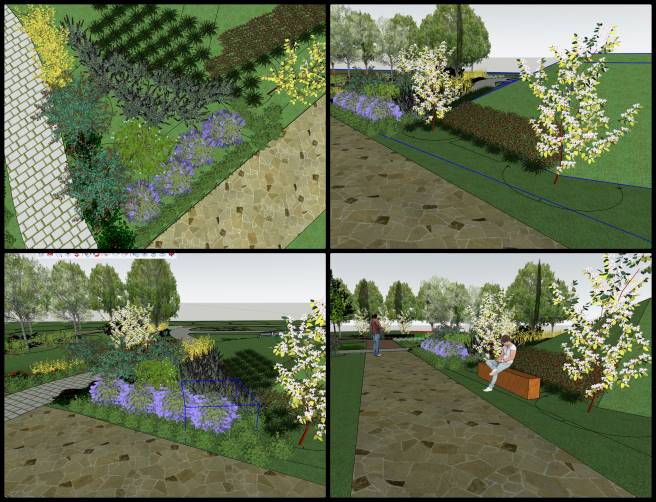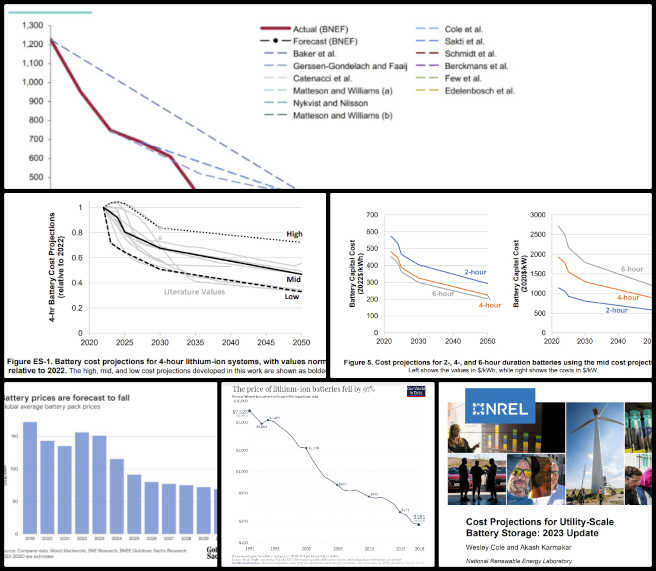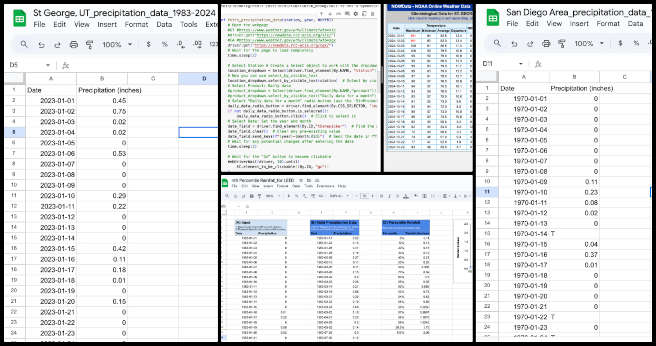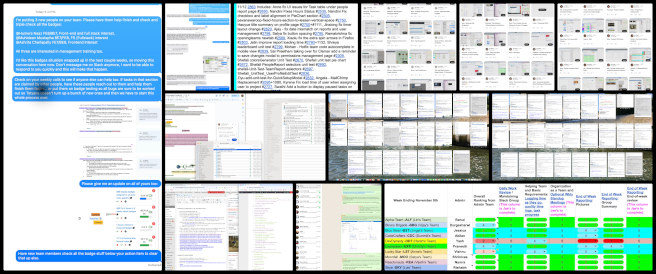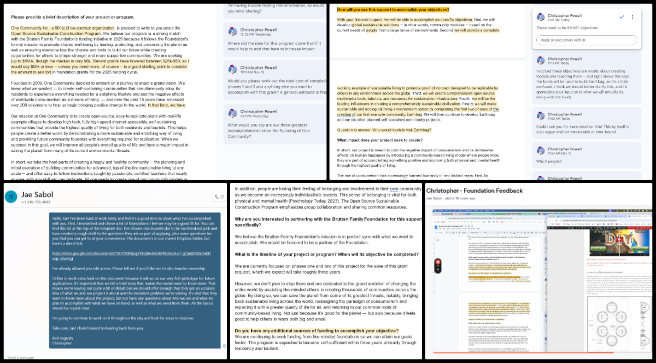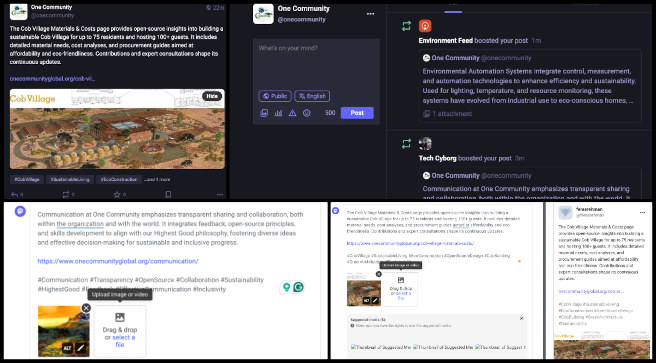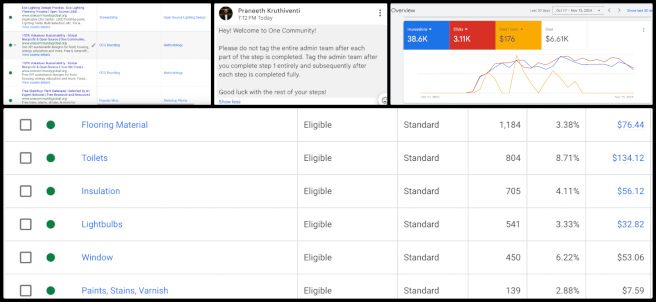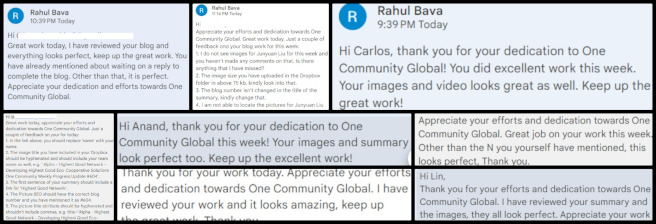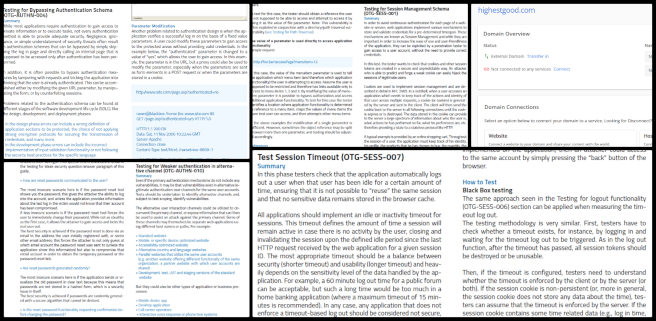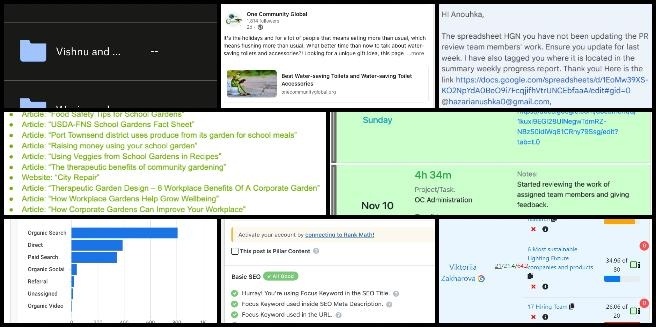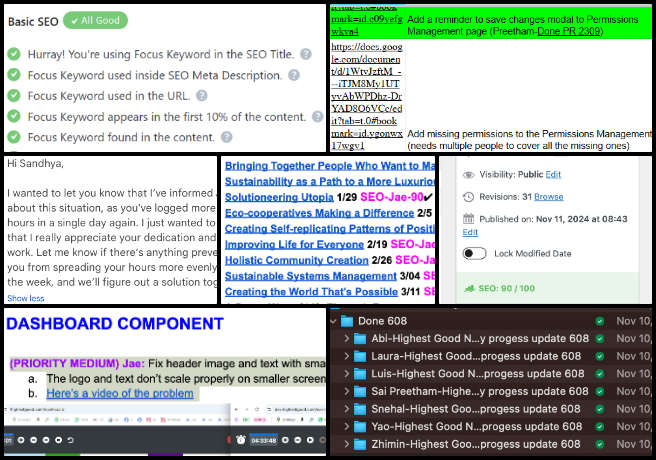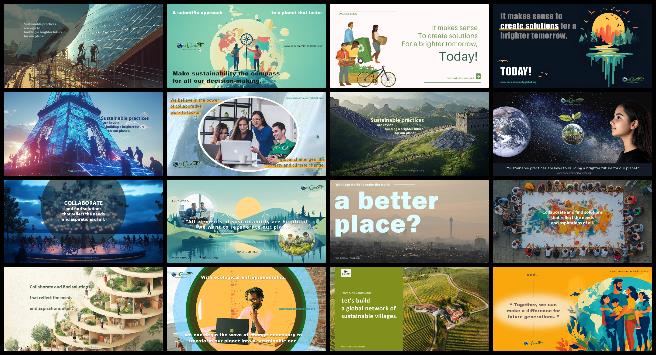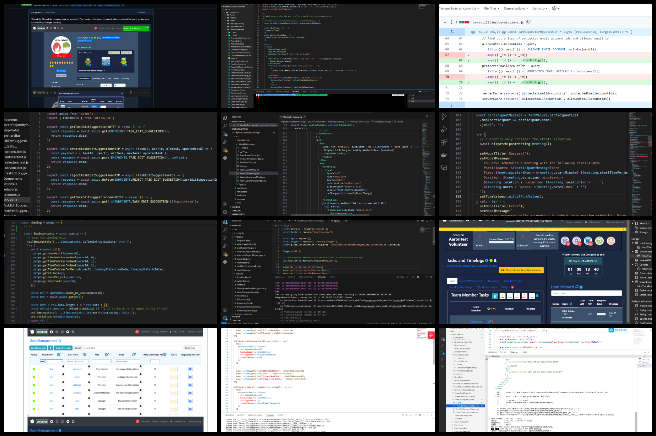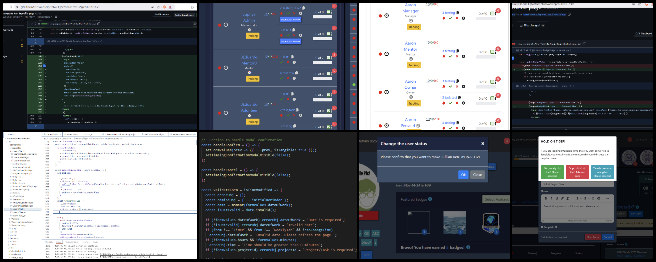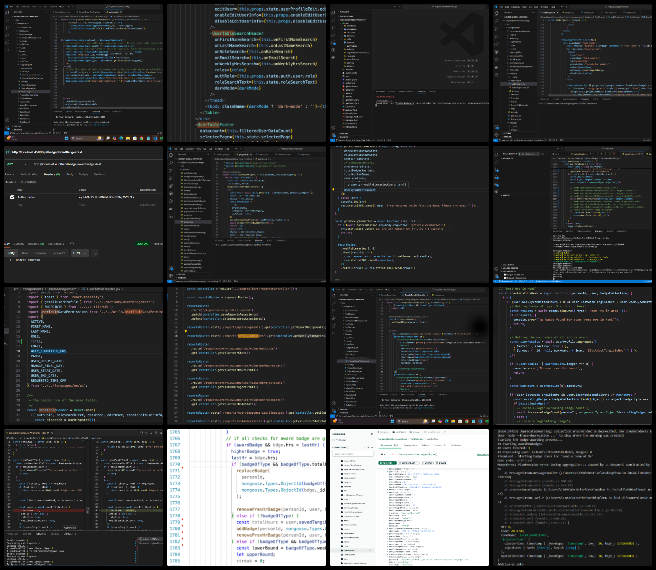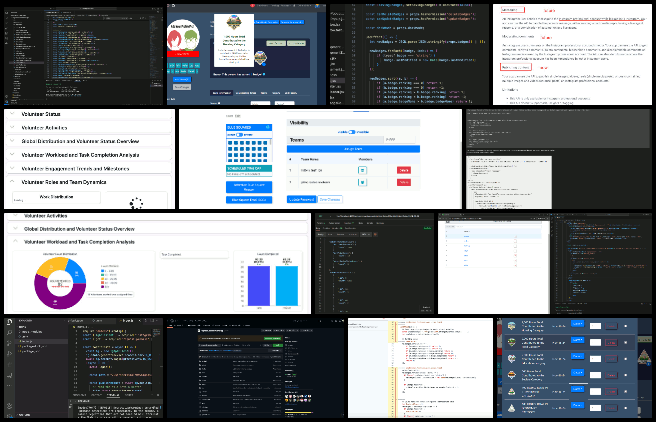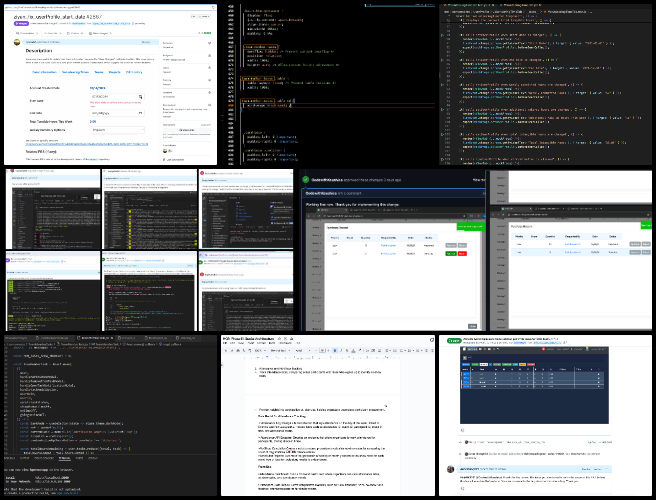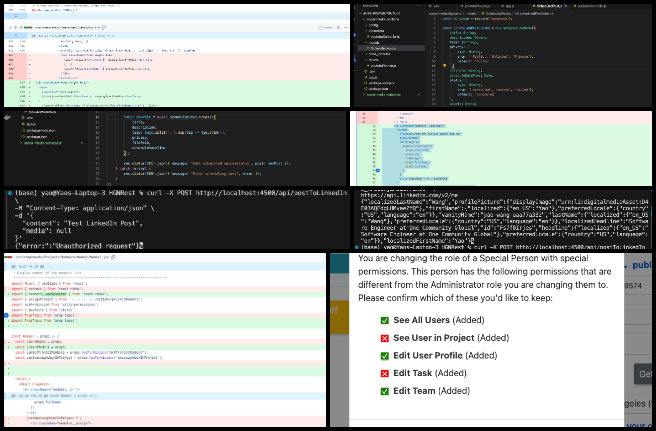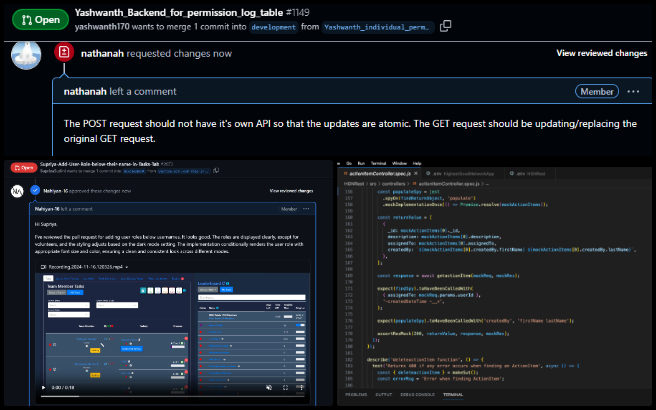Ongoing Path to Making No-Impact Living Mainstream – One Community Weekly Progress Update #609
At One Community, we are creating an ongoing path to making no-impact living mainstream to regenerate our planet and create a world that works for everyone. Our all-volunteer team is focused on sustainable approaches to food, energy, housing, education, economics, and social architecture. By open sourcing and free sharing the complete process, we aim to build a self-replicating model that inspires a global collaboration of teacher/demonstration hubs, all for “The Highest Good of All.” Together, we are evolving sustainability and fostering global stewardship practices that promote fulfilled living and lasting positive change.
- Here’s our ongoing path to making no-impact living mainstream project overview
- Here’s our world-change methodology
- Here’s how this becomes self-replicating
- Here’s how we are open source and free-sharing all the do-it-yourself designs
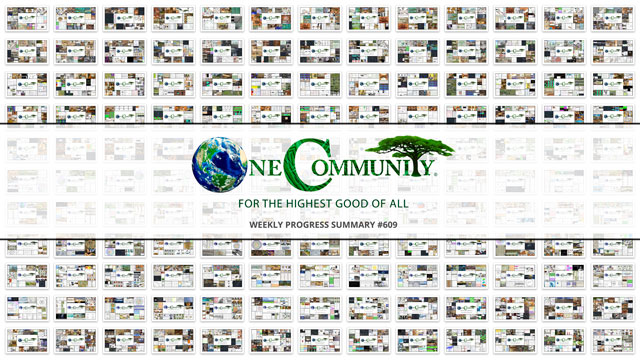
OUR MAIN OPEN SOURCE HUBS OF THE ONGOING PATH TO MAKING NO-IMPACT LVING MAINSTREAM
Click on each icon to be taken to the corresponding Highest Good hub page.
One Community’s physical location will forward this movement and ongoing path to making no-impact living mainstream as the first of many self-replicating teacher/demonstration communities, villages, and cities to be built around the world. This is the November 18th, 2024 edition (#609) of our weekly progress update detailing our team’s development and accomplishments in the ongoing path to making no-impact living mainstream.
Ongoing Path to Making
No-Impact Living Mainstream
One Community Progress Update #609
DONATE | COLLABORATE | HELP WITH LARGE-SCALE FUNDING
CLICK HERE IF YOU’D LIKE TO RECEIVE AN EMAIL EACH WEEK WHEN WE RELEASE A NEW UPDATE
YOU CAN ALSO JOIN US THROUGH SOCIAL MEDIA
ONE COMMUNITY WEEKLY UPDATE DETAILS
HIGHEST GOOD HOUSING PROGRESS
 One Community is creating an ongoing path to making no-impact living mainstream through Highest Good housing that is artistic and beautiful, more affordable, more space efficient, lasts longer, DIY buildable, and constructed with healthy and sustainable materials:
One Community is creating an ongoing path to making no-impact living mainstream through Highest Good housing that is artistic and beautiful, more affordable, more space efficient, lasts longer, DIY buildable, and constructed with healthy and sustainable materials:
- Learn about the crowdfunding campaign part of this ongoing path to making no-impact living mainstream: Our Upcoming Crowdfunding Campaign
- Learn about the different village models: 7 Sustainable Village Models
- Visit the open source portals for the first two villages as parts of this ongoing path to making no-impact living mainstream: Earthbag Village OS Hub | Straw Bale Village OS Hub
This week, Adil Zulfiquar (Engineer) continued working on the Vermiculture Toilet engineering and designs for an ongoing path to making no-impact living mainstream. He focused on the Vermiculture Transportation Solutions Report, involving revisions to include additional resources, references, and detailed information on vermiculture structures, along with the addition of relevant images. The section on narrow-body trailers was expanded, titles were reorganized for better clarity, and formatting adjustments were made to enhance readability and presentation. The Earthbag Village is the first of 7 to be built as the housing component of One Community’s open source model for an ongoing path to making no-impact living mainstream. See below for some of the pictures related to work.
Akshit Sethi (Architectural Designer) continued working on updating the Earthbag Village SketchUp and AutoCAD layouts. Akshit updated the base drawing set for the EarthBag Village essential in the ongoing path to making no-impact living mainstream, refining layers for improved readability, and preparing the drawings for publication. He shared the updated PDFs and AutoCAD files with the team for alignment and worked on finalizing the 3D model based on the revised CAD file, focusing on completing the final details to achieve a cohesive design. The Earthbag village is the first of 7 villages to be built as part of One Community’s open source model for an ongoing path to making no-impact living mainstream. See his work on the in the collage below.
Anil Karathra (Mechanical Engineer) continued helping complete the Vermiculture Toilet engineering and designs. He focused on creating and uploading weekly summaries with screenshots, and final adjustments were made to the vermiculture collaboration document. The master task list was updated to include new team members in the ongoing path to making no-impact living mainstream. The collaboration document was reorganized and reformatted to integrate research findings from Adil and refined based on recent feedback. A weekly team meeting was attended, and the slider FEA analysis was redone as a multi-step process to capture a stress-strain curve, with the analysis incorporated into the document. Additionally, documentation was edited based on suggestions from Manjiri, and work commenced on compiling a spreadsheet for the bill of materials. The approach for an ongoing path to making no-impact living mainstream enables the development of innovative solutions that are both environmentally friendly and effective. See below for some of the pictures related to the work.
Avery Hamilton (Mechanical Designer) continued working on finalizing the interior of the Earthbag Village 4-dome home design as a strategy for the ongoing path to making no-impact living mainstream. Avery added a floor drain for the spa space and a wall hydrant for the spa equipment. He integrated family types into Revit to generate schedules for new fixtures, routed refrigerant lines for mini-split systems, created details for pipe penetrations, and reselected the range hood. The Earthbag village is the first of 7 villages to be built as part of One Community’s open source model for an ongoing path to making no-impact living mainstream. See the work in the collage below.
Charles Gooley (Web Designer) continued working on the Aircrete Engineering and Research: Compression Testing, Mix Ratios, R-value, and More page. Charles updated the Aircrete Engineering and Research page focused on compression testing, mix ratios, R-value, and related topics. He documented the engineering processes, research, resources, and tools used to validate the safety of discrete designs and structures key in the ongoing path to making no-impact living mainstream. Tasks included verifying that no content was lost after a website crash and linking the tables of contents using anchor links for the Initial Trial Phase and Final Testing Phase sections. Aircrete is an alternative we’re exploring for the Earthbag Village, a foundational part of One Community’s open-source model for an ongoing path to making no-impact living mainstream. Take a look at some of the work in the images below.
Joseph Osayande (Mechanical Engineer) continued helping finish the Vermiculture Toilet engineering and design details. Joseph focused his efforts on revising the ongoing path to making no-impact living mainstream; main document for the Waste Removal System (WRS), including updates to values, enhanced readability, and the addition of diagrams to illustrate key concepts and support the design phase. Considerations were documented regarding potential external forces that might impact the connection to the main chamber, addressing any remaining concerns before moving forward with the build. The Earthbag Village is the first of 7 to be built as the housing component of One Community’s open source model for an ongoing path to making no-impact living mainstream. See some of his work in the collage below.
Karthik Pillai (Mechanical Engineer) continued helping finish the Vermiculture Toilet engineering and helping with the Earthbag Village 4-dome home roof plan. Karthik focused on the four-dome cluster roof project, addressing key structural elements central in the ongoing path to making no-impact living mainstream. He completed live load calculations and corrected discrepancies from a previous finite element analysis that used incorrect load values to ensure alignment with project requirements. Additionally, he refined the roof design with guidance from Michaela to enhance functionality and performance. Progress was also made on the vermiculture toilet design project, with ongoing adjustments to meet design specifications and improve operational effectiveness. The Earthbag Village is the first of 7 to be built as the housing component of One Community’s open source model for an ongoing path to making no-impact living mainstream. See the work in the collage below.
Michaela Silva (Architect) continued working on finalizing the interior details for the Earthbag Village 4-dome home design. Michaela facilitated meetings with Avery to address MEP (Mechanical, Electrical, and Plumbing) issues and with Karthik to review roof design details. She suggested positioning the mini-split units above bedroom doors to enable the ongoing path to making no-impact living mainstream routing refrigerant lines and power through the ceiling and into the main roof structure via a bump-out in the loft space. Additionally, she researched options for the roof deck finish and reviewed relevant structural codes. The Earthbag Village is the first of 7 villages to be built as part of One Community’s open source model for an ongoing path to making no-impact living mainstream. See her work in the collage below.
DUPLICABLE CITY CENTER PROGRESS
 One Community is creating an ongoing path to making no-impact living mainstream through a Duplicable and Sustainable City Center that is LEED Platinum certified/Sustainable, can feed 200 people at a time, provides laundry for over 300 people, is beautiful, spacious, and saves resources, money, and space:
One Community is creating an ongoing path to making no-impact living mainstream through a Duplicable and Sustainable City Center that is LEED Platinum certified/Sustainable, can feed 200 people at a time, provides laundry for over 300 people, is beautiful, spacious, and saves resources, money, and space:
- Learn about this ongoing path to making no-impact living mainstream building and its function: Duplicable City Center Open Source Hub
This week, Adithya Bhalaji (Mechanical Engineer) explored various types of dormer designs available in the market and studied commonly used materials for windows and dormer construction, focusing on their insulation properties for the dormer interior. He brainstormed potential dormer designs based on aesthetic and functional requirements, developing concept sketches for consideration. Additionally, Adithya worked on designing components such as window frames, glass elements, and the overall exterior structure of the dormer, utilizing SolidWorks software. The resulting images were uploaded to Dropbox and a copy was also saved in Google Docs for reference. The Duplicable City Center represents a fundamental element of One Community’s open-source approach, dedicated to an ongoing path to making no-impact living mainstream. View examples of this work in the pictures provided below.
Arnob Mutsuddi (Mechanical Engineer) continued working on Duplicable City Center structural engineering model and details. His work focused on completing design alterations for the hub connector in row 4, addressing GD&T issues with the side struts and middle ring, and finalizing the row 4 hub connector design with GD&T verification. Efforts transitioned to the hub connector design for row 6, with progress made on the middle ring. A team meeting was held, during which guidance was provided to a team member on the hub connector design. The Duplicable City Center is a foundational part of One Community’s open-source model, which excels in an ongoing path to making no-impact living mainstream. This approach is integral to their mission through innovative and scalable solutions. See some of this work in the pictures below.
Chris Blair (GIS Technician/Horticulturist) continued working with GIS data as part of One Community’s Permaculture Design which includes the location of the Duplicable City Center. He completed scaling, digitizing, and georeferencing the villages and community center based on revised area measurements of their footprints. Using these accurately scaled footprints, he analyzed and placed them in optimal locations on the property, considering level ground and solar aspects. Additionally, Chris reworked the slope map to increase detail and applied the clump tool to group areas with similar slopes, improving the map’s clarity. Within One Community’s open-source framework, the Duplicable City Center plays a central role in the ongoing path to making no-impact living mainstream. The images below showcase some of the work.
Faeq Abu Alia (Architectural Engineer) continued his work on the Duplicable City Center kitchen renders. He refined the Duplicable City Center kitchen model in SketchUp by implementing feedback, addressing design issues, and incorporating elements such as food items and human figures to enhance visual realism. In Lumion, he adjusted materials, added more human figures, and worked on three paths for kitchen walkthrough videos, rendering essential shots to improve the presentation. These updates were focused on aligning the model with project feedback and enhancing the overall quality of the visual experience. The Duplicable City Center represents a fundamental element of One Community’s open-source approach, dedicated to an ongoing path to making no-impact living mainstream. View examples of the work in the pictures provided below.
Jason Bao (Architectural Designer) continued working on producing renders for the Duplicable City Center library. This week he focused on setting up and rendering scenes for the library of the Duplicable City Center to showcase its ongoing path to making no-impact living mainstream versatility as a multi-purpose room. Modifications to the SketchUp model included adding books, toys, and other amenities to bookshelves and arranging furniture to create realistic settings. Scenes depicting a sports night, movie night, class gathering, and reading session were developed. In Lumion, adjustments were made to lighting, object placements, and render settings, with final renders uploaded to Dropbox for review. The Duplicable City Center is a foundational part of One Community’s open-source model, which excels in an ongoing path to making no-impact living mainstream. This approach is integral to their mission through innovative and scalable solutions. See some of this work in the pictures below.
Mohammed Maaz Siddiqui (Architect) continued working on the outdoor landscape areas for the Duplicable City Center; ongoing path to making no-impact living mainstream project. He focused on developing the front landscape area of the Duplicable City Center by integrating trees based on permaculture plans, and selecting and planting specified or similar species to align with design requirements. He enhanced the landscape’s volume by increasing tree density and incorporating undergrowth to reduce the appearance of emptiness. Additional plants, trees, and flowers were added to create a more vibrant and engaging environment. Changes were made to the landscape based on review feedback to refine the overall scene. Within One Community’s open-source framework, the Duplicable City Center plays a central role in an ongoing path to making no-impact living mainstream. The images below showcase some of this work.
Nika Gavran (Industrial Designer) continued her work on the Duplicable City Center dormer window installation plans. She focused on expanding the final document for the ongoing path to making no-impact living mainstream; dormer window instructions, progressing with the next steps in the assembly, primarily involving the window’s exterior. With the window now fully assembled, she began refining the renders by removing shadows and adding graphics, such as arrows, to ensure the instructions were clear and easy to follow. As a foundational component of One Community’s open-source strategy, the Duplicable City Center is designed for an ongoing path to making no-impact living mainstream. The images below showcase some of this work.
Sanket Basannavar (Mechanical Engineer) continued working on the Duplicable City Center spa cover as part of the City Center Natural Pool and Eco-spa Designs. This week, he continued his research on the structure and materials used in spa covers currently available in the market. The design of the spa cover was completed, and static stress analysis was performed, showing minimal displacement under a 200 lbs load and low stress on the cover. A static thermal analysis was also conducted, but the results were less favorable, with a low R-value indicating insufficient thermal resistance. Within One Community’s open-source framework, the Duplicable City Center plays a central role in the ongoing path to making no-impact living mainstream. The images below showcase some of this work.
Tasmia Hasan (Design Engineer) continued her work on the structural engineering of the Duplicable City Center. She adjusted the angle of the steel struts to 66.18 degrees using trial-and-error methods to address alignment challenges in the structure. During a group meeting, she collaborated with the team to review design modifications and explore potential areas for further optimization. Tasmia also worked closely with Arnob to identify an improved approach for refining the design, focusing on structural integrity and practicality. She conducted additional evaluations to ensure that the adjustments met project specifications and supported the overall objectives of the work. As a foundational component of One Community’s open-source strategy, the Duplicable City Center is designed for the ongoing path to making no-impact living mainstream. You can see examples of this work in the following images.
Yan Zu (Architectural Designer) continued her work on the greenhouse area of the Duplicable City Center. This week, she enhanced the greenhouse exterior by adding diverse plants and people to create a natural atmosphere. Stones were placed around the pond to improve its appearance and integrate it better with the surroundings. The four-tiered platform was populated with people to showcase interaction and activity, highlighting its functionality. An animation was created to demonstrate the platform’s design features, structural details, and how it integrates with the surrounding environment, providing a clear representation of the space. Within One Community’s open-source framework, the Duplicable City Center plays a central role in our ongoing path to making no-impact living mainstream. The images below showcase some of this work.
Yancong E (Architectural Designer) continued working on the Duplicable City Center project. He updated the outdoor view analysis floorplan to reflect the latest revisions, ensuring alignment with the current plan. He refined the overall analysis description and adjusted the formatting for consistency with the website. Additionally, Yancong conducted individual floor analyses, detailing room-specific information and identifying those eligible for points. The Duplicable City Center represents a fundamental element of One Community’s open-source approach, dedicated to creating an ongoing path to making no-impact living mainstream. This innovative initiative aims to showcase how creating patterns of positive change can transform urban spaces into more sustainable and community-oriented environments. You can see examples of this work in the following images.
HIGHEST GOOD FOOD PROGRESS
 One Community is creating an ongoing path to making no-impact living mainstream through Highest Good food that is more diverse, more nutritious, locally grown, and sustainable, and part of our open source botanical garden model to support and share biodiversity:
One Community is creating an ongoing path to making no-impact living mainstream through Highest Good food that is more diverse, more nutritious, locally grown, and sustainable, and part of our open source botanical garden model to support and share biodiversity:
- Learn about the structures of an ongoing path to making no-impact living mainstream: Hoop House Hub | Aquapini & Walipini Open Source Hub
- See what we’ll be growing: Gardens & Hoop Houses | Large-scale Structures | Food Forest | TA
This week, the core team continued their research on the Earthbag Village Tools, Equipment, and Materials/Supplies list and initiated the review of necessary tools for the Apiary Tools, Equipment, and Materials/Supplies list. Additionally, they added photos to the weekly summary and reviewed an electrical drawing for the Earthbag Village, providing recommendations and suggestions for updating the subpanel and its contents. The Earthbag Village is the first of 7 to be built as the housing component of One Community’s open source model for an ongoing path to making no-impact living mainstream. See below for some of the pictures related to this work.
Jay Nair (BIM Designer) continued working on Aquapini and Walipini Planting and Harvesting lighting and HVAC design. He focused on revising the lighting specifications for the greenhouse project to account for the 6,000-foot elevation of the site. Adjustments were made to the lighting requirements for various plant species, considering the increased solar radiation and temperature variations associated with high-altitude environments. A lighting schedule was developed to ensure the accurate implementation of these specifications. Additionally, research was conducted on the plumbing needs for Walipini 1, including water supply, drainage, and irrigation systems, to support optimal plant growth and facility operations. The Highest Good Food initiative is a key component of One Community’s open source plans, dedicated to an ongoing path to making no-impact living mainstream, and exemplifies the organization’s commitment through innovative design and implementation. Below are some of the images showcasing this work.
Purva Borkar (Landscape Architect) continued her work on creating an outdoor merge of a food-producing ecosystem and people spaces for the Aquapini and Walipini Planting and Harvesting structures. She worked on a CAD drawing of a landscape design centered around a rain garden designed to manage stormwater overflow. The project integrated sustainable features with passive recreation spaces, including pathways, seating areas, and gathering zones. The design incorporated diverse plantings and natural elements to enhance biodiversity and support stormwater filtration. Additional visuals included diagrams and a constructed boardwalk pathway, emphasizing accessibility and the integration of built and natural environments. As part of One Community’s open source efforts, the Highest Good Food initiative embodies a commitment to an ongoing path to making no-impact living mainstream. The images below offer a glimpse into these ongoing efforts.
Surya Teja Anumolu (Volunteer Mechanical Engineer) continued his work on the Highest Good Food most sustainable construction and agricultural equipment. He focused on creating Aquapini and Walipini Planting and Harvesting footprint drawings to identify areas at each level that could be categorized as usable and walkable. Using the master AutoCAD file from the OneCommunity Dropbox folder, he produced five distinct drawings, including layouts for the underground level, floor level, walkable areas, and a landscaping plan, with the latter also providing area annotations in multiple units. The Highest Good Food initiative is a key component of One Community’s open-source plans, dedicated to an ongoing path to making no-impact living mainstream. This approach is critical to ensure alignment with the initiative’s goals. See his work in the collage below.
Syahrina Maulida Majid (Volunteer Nutritionist) continued working on creating menu implementation tutorials as a part of One Community’s Transition Food Self-Sufficiency Plan. She worked on menu implementation by refining and testing the master recipe template. She developed step-by-step instructions for a tutorial to guide users on data input, adapting the template to different dietary needs, and interpreting its outputs. Observations from earlier testing were integrated to address potential challenges and enhance the tutorial’s clarity. Additionally, she documented examples to provide practical context, ensuring the tutorial is accessible and applicable to a variety of users. The Highest Good Food initiative plays a crucial role in One Community’s open source plans, with the aim of an ongoing path to making no-impact living mainstream. Her work is showcased in the collage below.
Vatsal Tapiawala (Mechanical Engineer) continued working on integrating ideas from Paul Wheaton’s Truly Passive Greenhouse” designs into the Aquapini/Walipinis structures. He worked on key aspects of the project, including designing a 3-foot-deep lowered walkway for Walipini 1 to improve thermal efficiency. He used the energy analytical model in Revit to analyze the performance of Walipini 1 and refine its design. Additionally, Vatsal began addressing the process of calculating heating and cooling loads using Revit. The Highest Good Food initiative is a key component of One Community’s open source plans, dedicated to an ongoing path to making no-impact living mainstream. See his work in the collage below.
Ziyi Chen (Landscape Designer) continued working on the design of the outdoor spaces for the Aquapini/Walipinis structures. She finalized tree species selections, refined planting models, and advanced the plant design along the southeastern road with a focus on creating a visually engaging and sensory-rich environment. Mint was included along the roadside to encourage sensory interaction, while fruit-bearing plants such as lingonberries were placed further back to add functional and visual interest. Four-season plants like dogwood were positioned to ensure year-round appeal, featuring red branches visible in winter without interfering with shade. Groundcover plants, including Ophiopogon japonicus and ceanothus, were chosen for slopes in the Zenapini area due to their adaptability to well-drained soil and suitability for local conditions. Human models were also incorporated into the design to evaluate the layout’s appearance at human scale. The Highest Good Food initiative is a key component of One Community’s open source plans, dedicated to an ongoing path to making no-impact living mainstream. See her work in the collage below.
HIGHEST GOOD ENERGY PROGRESS
 One Community is creating an ongoing path to making no-impact living mainstream through Highest Good energy that is more sustainable, resilient, supports self-sufficiency and includes solar, wind, hydro and more:
One Community is creating an ongoing path to making no-impact living mainstream through Highest Good energy that is more sustainable, resilient, supports self-sufficiency and includes solar, wind, hydro and more:
- Learn about the open source sustainable energy foundations: Solar, Hydro, and Wind
- Explore our research into the most sustainable products and companies for saving water and energy: Insulation, Eco-laundry, Lightbulbs and Light Bulb Companies, Doors and Door Companies, Windows and Window Companies, Toilets, Faucets and Faucet Accessories, Urinals, and more.
This week, Sarmad Tariq (Electrical Engineer) continued helping finish the Highest Good energy component and evaluating grid-tie vs off-grid solar design. This week he reviewed all the introductory documents and previously published web pages to understand HGN and its end goal. These included websites for solar microgrid setup, solar incentive rates, and a phased Duplicable City Center project rollout. Moreover, Sarmad looked at different projections of battery prices and the future trend of battery prices according to different models provided by NREL and other organizations. The team has made significant progress within One Community’s open-source framework, the Duplicable City Center plays a central role in the ongoing path to making no-impact living mainstream. Take a look at some of this work in the images below.
Viktoriia Zakharova (Administrative Assistant) continued her research to complete the update of the Most Sustainable Lightbulbs and Light Bulb Companies. This week, Viktoriia researched sustainable materials for lighting fixtures, verified quantities in the original Duplicable City Center spreadsheet, and read scientific literature on sustainable fixtures, noting key highlights. She also scheduled and conducted hiring interviews with three volunteer candidates, and reviewed the progress of the Highest Good Food team, provided comments, created collages, and published updates on her WordPress page. Additionally, Viktoriia reviewed the work of other administrators, added missing pictures and people omitted from the blog to her page. The Duplicable City Center represents a fundamental element of One Community’s open-source approach, which is dedicated to the ongoing path to making no-impact living mainstream. View examples of this work in the pictures provided below.
Yi-Ju Lien (Environmental Engineer) continued her work on the Highest Good energy LEED points related to stormwater retention. This week she worked on data collection and spreadsheet development to meet the LEED requirement through Option 1: Retaining the 95th Percentile Storm onsite. She gathered over 30 years of daily data from the monitoring station to ensure an unbiased analysis developed functions to filter out invalid data and calculated the percentile rainfall. She also created visualizations and refined the summary table to check whether the selected site met the required stormwater retention facility size. The Duplicable City Center represents a fundamental element of One Community’s open-source approach, which is dedicated to the ongoing path to making no-impact living mainstream. Below is a collage of this work.
HIGHEST GOOD EDUCATION PROGRESS
 One Community is creating an ongoing path to making no-impact living mainstream through Highest Good education that is for all ages, applicable in any environment, adaptable to individual needs, far exceeds traditional education standards, and more fun for both the teachers and the students. This component of One Community is about 95% complete with only the Open Source School Licensing and Ultimate Classroom construction and assembly details remaining to be finished. With over 8 years of work invested in the process, the sections below are all complete until we move onto the property and continue the development and open sourcing process with teachers and students – a development process that is built directly into the structure of the education program and everything else we’re creating too:
One Community is creating an ongoing path to making no-impact living mainstream through Highest Good education that is for all ages, applicable in any environment, adaptable to individual needs, far exceeds traditional education standards, and more fun for both the teachers and the students. This component of One Community is about 95% complete with only the Open Source School Licensing and Ultimate Classroom construction and assembly details remaining to be finished. With over 8 years of work invested in the process, the sections below are all complete until we move onto the property and continue the development and open sourcing process with teachers and students – a development process that is built directly into the structure of the education program and everything else we’re creating too:
- Program Overview: Education Open Source Hub
- How the components work together in designing human orchestrated eco-abundance: How to use the Education for Life Program
- Lesson Plans for Life – Lesson Plans How-to
- Foundations of Outstanding Leaders, Teachers, and Communicators
- Curriculum for Life
- Teaching Strategies for Life
- Learning Tools and Toys for Life
- Evaluation and Evolution
This week, Apoorv Pandey (Mechanical Engineer) continued helping with the engineering details for the Ultimate Classroom part of the Highest Good Education component. He continued working on the final draft of the Structural Engineering Report for the Ultimate Classroom Project, focusing on the changes recommended by Jae. He worked on making the AutoCAD files more presentable, especially the detailing of each drawing. He is currently logging all of his work in a video format for a varied explanation of all the work he’s done. He researched ways to simplify the explanation of technical tables, such as the static check table and the beam force detail summary, to make the content more accessible to a layperson. Additionally, Apoorv is reworking the formatting of certain sections and referencing other published materials on One Community’s website to guide his work. The One Community model of combining forward-thinking education with sustainably built classrooms like this is an excellent example of an ongoing path to making no-impact living mainstream. This approach exemplifies by creating environments fostering collaboration and innovation. See the collage below for his work.
HIGHEST GOOD SOCIETY PROGRESS
 One Community is creating an ongoing path to making no-impact living mainstream through a Highest Good society approach to living that is founded on fulfilled living, the study of meeting human needs, Community, and making a difference in the world:
One Community is creating an ongoing path to making no-impact living mainstream through a Highest Good society approach to living that is founded on fulfilled living, the study of meeting human needs, Community, and making a difference in the world:
- Read the Highest Good society overview: Highest Good Society
- Learn about the model for fulfilled living and sharing as part of One Community’s ongoing path to making no-impact living mainstream: A Day in the Life
- Learn about the 4 economic models that are part of our ongoing path to making no-impact living mainstream: RBE | For-profit | Non-profit | Entrepreneurship
- Learn about our open source community collaboration and management software: The Highest Good Network
This week, the core team completed over 64 hours managing One Community’s volunteer-work review not included above, emails, social media accounts, web development, new bug identification and bug-fix integration for the Highest Good Network software, and interviewing and getting set up new volunteer team members. They also shot and incorporated the video above that talks about One Community and how this ongoing path to making no-impact living mainstream is a foundation of the bigger picture of everything One Community is doing. The image below shows some of this work.
Anoushka Hazari (Data Analyst) continued working on code for automating and simplifying the Highest Good Network software promotion process. This week, she fixed the mix-up between the PR review table and the HGN spreadsheet was resolved with guidance from the manager. The blog was completed, a collage was created, and the PR review table for the week was finalized, awaiting managerial review. Suggestions were provided to team members on their upcoming tasks. Work continued in automating the PR promotion messages, addressing errors in the process, and creating a new Google Console key to reconnect the Google Sheet. Additionally, a Slack bot named “Promotion App” was developed to automate and improve the process of sending promotion messages within Slack channels. This involved troubleshooting code errors and exploring new functionalities to enhance efficiency. The automation for Slack notifications was completed and made fully functional, and a Loom video was recorded to clarify questions about the HGN Google Sheet of PR reviews. Feedback from the manager was incorporated into ongoing tasks. Images were added to the Week 7 Dropbox folder, and all work was double-checked before submission on Slack. This work helps One Community’s mission and reinforces our commitment to the ongoing path to making no-impact living mainstream. The following images show her work for the week.
Christopher Powell (Grant Writer) continued helping with grant writing as a source of funding. This week, he completed a rough draft of the Brutten Family Foundation Letter of Intent (LOI), addressing key questions related to the project’s objectives and the reasons for its funding. He submitted the draft to Jae for feedback, which was reviewed and will be considered further in the coming week. The LOI required extensive research on One Community, including gathering detailed information on the organization and its primary project, with additional work planned to finalize the content. This work helps One Community’s mission and reinforces our commitment to the ongoing path to making no-impact living mainstream. The following images show his work for the week.
Feras Rehman (Data Analyst) continued working on developing One Community’s Mastodon account and strategy. He also managed his part of the One Community Updates Blog by reviewing and adding images to supplement the summary. Sneka, Ratna, Saumit, and Yash were reviewed, and feedback was provided on identified errors. Five more Mastodon posts were scheduled on Buffer for the upcoming week. Targeted Mastodon strategies were developed and implemented, resulting in a fivefold increase in post reach through optimized hashtag usage and improved post structuring. This work helps One Community’s mission and reinforces our commitment to the ongoing path to making no-impact living mainstream. The following images show his work for the week.
Praneeth Kruthiventi (Volunteer Data Analyst) continued helping manage the One Community Google Ads campaigns. He optimized the active Google Ads campaigns by updating keywords and descriptions to enhance their relevance. He interviewed two candidates for Software Developer roles and scheduled two additional interviews for the following week. Praneeth also explored methods for generating automated reports to monitor the performance of ongoing Google Ads campaigns. Additionally, he reviewed training exercises completed by new volunteers and contributed to the hiring process for upcoming positions. This work helps One Community’s mission and reinforces our commitment to the ongoing path to making no-impact living mainstream. The following images show his work for the week.
Rahul Bavanandan (Data Analyst) continued working on several key projects within the Highest Good Network software, One Community’s Reddit presence, and administration. He continued his work on the HGN Phase 2 Evolution project, focusing on translating Figma designs for the Phase 2 dashboard. He also engaged with diverse posts on Reddit to enhance his comment karma and contributed original content across various subreddits to establish a strong presence, refining and formatting a document outlining an effective Reddit strategy. Rahul continued building his Reddit presence by actively engaging in conversations across various subreddits. Rahul curated content for the weekly progress update, which involved adding weekly summaries and photo collages to the webpage. He also reviewed summaries and images submitted by team members, provided constructive feedback, and reviewed the work of two others in the Step 4 Document. Additionally, he filled out the Step 2, Step 4, and HGN Questionnaire (Responses) documents. This work helps One Community’s mission and reinforces our commitment to the ongoing path to making no-impact living mainstream. The following images show his work for the week.
Shireen Kayal (Humanitarian Program Developer & Data Manager) continued her work on branding graphics for all of One Community. She focused on preparing for upcoming tasks by researching the One Community website, particularly the Highest Good Energy page. She also updated and improved the Week 13 folder by replacing images with newer versions, adjusting URLs, and eliminating double dashes. Additionally, Shireen created new designs for the “Our Values” section on the Our Pledge page and developed fresh images for social media and the website. This work helps One Community’s mission and reinforces our commitment to the ongoing path to making no-impact living mainstream. The following images show her work for the week.
Vatsal Mendpara (Security Analyst) began working on a new task assigned through the website, focusing on preparing a detailed report on individual user usage of the HGN application for time logging. He analyzed resources utilized by the HGN application across both servers and started creating a checklist for testing website security mechanisms. Additionally, Vatsal worked on compiling a report about the usage of the HGN application across both servers and developed a checklist detailing critical points for web application testing, initiating work on those points. He also progressed on a checklist for server security, documenting all identified bugs and potential vulnerabilities. Finally, Vatsal began testing the web security of onecommunityglobal.org, creating reports on vulnerabilities in alignment with the OWASP Top 10. This work helps One Community’s mission and reinforces our commitment to the ongoing path to making no-impact living mainstream. The following images show his work for the week.
Venkata Jaya Pavan Naru (Volunteer Network And Cybersecurity Engineer) continued helping with the One Community website and Highest Good Network software stability and security. He tested website speed tests to ensure stability and consistent performance, with results showing an “A” grade across all servers. He also reset the server and performed phase 1 of a cybersecurity task. Monitored website health, participated in a meeting with Gavin to discuss upcoming cybersecurity implementations for HGN, and worked on a new cybersecurity proposal. This work helps One Community’s mission and reinforces our commitment to the ongoing path to making no-impact living mainstream. The following images show his work for the week.
Yash Shah (Data Analyst and Team Administrator) continued his admin work and managed the social architecture component of the Highest Good Network software. He worked on tasks related to HGN Phase 3 allocated to teammates, with specific action items segregated and organized. Assistance was provided to Khushi with Figma, including resolving comments and aligning designs with requirements. A weekly meeting for Phase 3 was facilitated, during which Shreya and Vaibhavi were assigned to provide input from the development side. Additionally, he also created a blog for Dev Dynasty, organizing the weekly folder, providing feedback, and preparing the summary for the week in the manager’s absence. This work helps One Community’s mission of an ongoing path to making no-impact living mainstream and reinforces our commitment to the ongoing path to making no-impact living mainstream. The following images show his work for the week.
ADMINISTRATION TEAM A-O
The Administration Team’s summary, covering their work administrating and managing most of One Community’s ongoing path to making no-impact living mainstream was managed by Muhammad Huzaifah (Administrative Assistant) and includes, Durgeshwari Naikwade (Data Analyst), Jessica Fairbanks (Administrative Assistant), Michael Juma (Administrative Assistant), Kishan Sivakumar (Administrative Assistant and Software Team Manager), Jibin Joby (Data Analyst), Vishnu Murali (Data Analyst) and Olawunmi “Ola” Ijisesan (Administrative and Management Support). This week, Durgeshwari collaborated with the Google Analytics team to update the strategy for a Google Ads campaign, initiated market research, and explored search engine console features for a marketing strategy. She also created LinkedIn posts and contributed to the Binary Brigade for the One Community Weekly Progress Update #608. Jessica completed administrative duties, created a collage, reviewed progress updates of team members, and provided feedback to fellow administrators. She also advanced the Highest Good Food infrastructure plan by researching and adding information on corporate gardens.
Jibin did his part helping create an ongoing path to making no-impact living mainstream as he attended the Google Analytics meeting, participated in strategy discussions, reviewed team work, and expanded his knowledge through videos. He researched dashboard layouts and reporting to enhance the analytics setup and improve data-driven insights. Kishan completed senior admin tasks, reviewed volunteer documents, tracked progress, addressed requests, and conducted SEO page reviews. He also completed a weekly blog and revisited optimized pages based on feedback. Michael managed the energy team, provided feedback on their progress, and researched the design and budgeting aspects of a Google AdWords campaign.
Huzaifah contributed to administrative tasks, conducted a blog audit, followed up on team bios, and focused on deadline management by coordinating task updates with volunteers. Ola did her part helping create an ongoing path to making no-impact living mainstream as she oversaw PR review managers, ensured task completion, monitored reporting through HGN spreadsheets, and provided feedback on PR reviews. Vishnu planned event tagging for improved Google Analytics reporting, participated in a meeting to outline next steps, reviewed team contributions, and updated the blog to align with project objectives. One Community’s model for an ongoing path to making no-impact living mainstream includes developing and maintaining a supportive administration team like this. You can see the work for the team in the image below.
ADMINISTRATION TEAM R-Z
The Administration Team’s summary, covering their work administrating and managing most of One Community’s ongoing process for the ongoing path to making no-impact living mainstream was managed by Sneka Vetriappan (Data Analyst) and includes Rachna Malav (Data Analyst), Ratna Meena Shivakumar (Data Analyst and Admin), Riddhisha Chitwadgi (Administrative Assistant), Rishabh Rao (Administrator), Saumit Chinchkhandi (Administrative Assistant and Software Engineer), Shrinivas Patil (Software Engineer) and Zuqi Li (Administrative Assistant and Economic Analyst). This week, Rachna interviewed three candidates, recorded meeting notes in the hiring team spreadsheet, and responded to emails. She also worked on SEO pages and assignments. Ratna focused on preparing the weekly summary, creating collages for blog posts, and scheduling social media posts for One Community’s Facebook and Instagram. She also had a discussion with Jae regarding the AI music project and reviewed and updated blog descriptions.
Riddhisha worked on video tutorials for blog transfer and prepared a tracking spreadsheet. She met with the analytics team, created documentation for using the spreadsheet, and transferred Blog #608 while performing SEO tasks, including keyword integration. Rishab completed the administrative tasks for Team Skye, uploading the team summary and collage to WordPress. He also gained access to the One Community Fan Page and Sustainable Lives Facebook page to strategize user engagement. Rishab did his part contributing our ongoing path to making no-impact living mainstream as he participated in his first meeting with the Google Analytics team. Saumit handled frontend testing for multiple pull requests, collaborating with developers to resolve conflicts. He also managed the review workflow for volunteers, updated his WordPress page with the team summary and collage, and reviewed Yash’s WordPress page, implementing feedback. Shrinivas provided feedback for Team Moonfall, worked on Blog #608, and assisted Sara with the admin feedback spreadsheet. He reviewed PDFs, corrected them, and managed the HGN PR review tracking spreadsheet. He organized urgent tasks and helped improve the tracking process.
Sneka also did her part contributing our ongoing path to making no-impact living mainstream as she reviewed and provided feedback on teammates’ work, including weekly blog entries and summaries, addressing errors to maintain quality. She updated the SEO page, added weekly summaries and collages to the webpage, and ensured clear communication throughout the team’s tasks. Zuqi organized the weekly summary for the Graphic Design Team, reviewed other admins’ summaries, and researched metrics for blog performance tracking. She also reviewed Google AdWords and Google Analytics documents to improve her understanding of these tools. One Community’s model for an ongoing path to making no-impact living mainstream includes developing and maintaining a supportive administration team like this. You can see the work for the team in the image below.
GRAPHIC DESIGN TEAM
The Graphic Design Team’s summary was managed by Zuqi Li (Administrative Assistant and Economic Analyst) and included Aurora Juang (Graphic Designer), Junyuan Liu (Graphic Designer, UI/UX Designer) and Jaime Yao (Creative Technologist), covering their work on graphic designs for an ongoing path to making no-impact living mainstream. This week, Aurora finalized the layout for the company’s presentation deck, completing internal sections such as the team profile, visual guidelines, and style sheets. She submitted these for review to Jae, incorporated the feedback, and made the necessary updates. Aurora also watched video tutorials to create custom icons for the contributor directory, edited images for the organization’s online volunteer showcase, and designed promotional assets by creating social media posts using the brand’s Instagram templates.
Jaime created an announcement image and a website for Viktoriia Zakharova. He also developed social media visuals based on previously outlined concepts, including “A Canvas of Change” and “Collaborative Spiral” for the theme “Collaborate and find solutions that reflect the needs and aspirations of all,” and “Solar Panel Eiffel Tower,” “Solar Great Wall,” and “Solar Sydney Opera House” for the theme “Sustainable practices are keys to building a brighter future for our planet.” Junyuan focused on creating social media content, gathering images, and exploring various design options, which resulted in three new social media images. He also began sourcing images and considering design ideas for the next image and participated in a meeting with Yash and others to assess potential adjustments for HGN Phase 3. See the Highest Good Society pages for more on how this contributes to an ongoing path to making no-impact living mainstream. See the collage below to view some of their work.
HIGHEST GOOD NETWORK PROGRESS
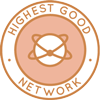 One Community is creating an ongoing path to making no-impact living mainstream through open source Highest Good Network® software that is a web-based application for collaboration, time tracking, and objective data collection. The purpose of the Highest Good Network is to provide software for internal operations and external cooperation. It is being designed for global use in support of the different countries and communities replicating the One Community sustainable village models and related components.
One Community is creating an ongoing path to making no-impact living mainstream through open source Highest Good Network® software that is a web-based application for collaboration, time tracking, and objective data collection. The purpose of the Highest Good Network is to provide software for internal operations and external cooperation. It is being designed for global use in support of the different countries and communities replicating the One Community sustainable village models and related components.
- Learn about our open-source community collaboration and management software: The Highest Good Network
This week, the core team continued their work on the Highest Good Network PRs testing, confirming the fixed PRs and resolving several issues. They confirmed fixes for several issues including Hours Status (#2535), title summary on the profile page (#2700), timer layout changes (#2820), opening teams in a new tab (#2589), and team code autocomplete in mobile view (#2839). Unresolved issues included UI problems on the People Report page for 375px and up (#2650), checkbox and label alignment in the PieChart section (#2505), vertical space usage in formatting (#2750), date mismatches in reports and user management (#2798), button spacing adjustments (#2795), report loading time improvements (#2780), and adding a reminder to save changes modal on the permissions management page (#2309).
Additionally, they logged five tangible hours for ‘CoreTeam TesterAgain’ to test hours accumulation over five blue squares. The test confirmed that the absence of a Weekly Summary Report should generate a sixth blue square and add one extra hour to the required hours for Core Team accounts. We continued to focus on the ongoing path to making no-impact living mainstream through iterative improvements and user-centric solutions. See the Highest Good Society and Highest Good Network pages for more on how this relates to the ongoing path to making no-impact living mainstream. The collage below shows some of their work.
ALPHA SOFTWARE DEVELOPMENT TEAM
The Alpha Team’s summary, covering their work on the Highest Good Network software software was managed by Lin Khant Htel (Frontend Software Developer) and includes Carlos Gomez (Full-Stack Software Developer), Nanguan Lin (Software Developer), Rupa Rajesh Bhatia (Software Engineer), and Sheetal Mangate (Software Engineer). The Highest Good Network software is how we will manage and measure our processes for an ongoing path to making no-impact living mainstream across our social architecture, construction, production, and maintenance processes.
This week, Lin reviewed and approved PR #2871, becoming more familiar with the codebase and testing the changes on his local machine, where all test cases passed. Lin also reviewed weekly summaries, photos, and videos submitted by his Alpha team members. Carlos collaborated with Howard on addressing a time log submission issue, reviewing initial bug reports on the ongoing path to making no-impact living mainstream; but was unable to reproduce the reported problems. Carlos requested a detailed video recording with audio to gather additional information, awaiting further input from Howard. Rupa worked on managerial tasks by reviewing team member summaries and evaluating completed work, including contributions from Lin, Nanguan, Carlos, and Sheetal.
Concurrently, Rupa developed Pages 1, 2, and 3 of a multi-step form in React, focusing on controlled components for efficient state management and capturing user data such as name, professional title, experience, and expertise. React Router was utilized for navigation between pages, with the structure and functionality established and styling in progress. Development also began on Pages 4 through 7, emphasizing consistent form handling and user experience. Sheetal concentrated on state management with Redux in React, reviewing the managingTeamsReducer.js file to deepen her understanding and support writing test cases. She also worked on a pull request for a new test file, ensuring compliance with best practices by consulting the “How to Create a Good PR” document. See the Highest Good Society and Highest Good Network pages for more on how this relates to the ongoing path to making no-impact living mainstream. View some of the team’s work in the collage below.
BINARY BRIGADE SOFTWARE DEVELOPMENT TEAM
The Binary Brigade Team’s summary overseeing advancements in the Highest Good Network software was managed by Vijay Anand Pandian (Full Stack Software Engineer) and includes Aaryaneil Nimbalkar (Software Developer), Anirudh Sampath Kumar (Software Developer), Ashish Nagaraju (Software Engineer), Ashmita Pandey (Software Engineer), Deepthi Kannan (Software Engineer), Huijie Liu (Software Engineer), Sai Venkatesh Voruganti (Volunteer Software Engineer), Sandhya Adavikolanu (Software Developer), Sriram Seelamneni (Software Engineer), Xiaolu Li (Software Engineer) and Ziyu Chu (Volunteer Software Engineer). The Highest Good Network software is how we’ll be managing and objectively measuring our process for an ongoing path to making no-impact living mainstream through our social architecture, construction, production, and maintenance processes.
This week, Aaryaneil prepared reports on changes in PR 972, the implementation of PR 1106, and the impact of PR 1105. He completed testing and reviews for frontend issues, including project title sorting (#2849), dropdown display (#2848), lint fixes (#2847, #2846), and updates from Rishitha (#2845), Nikita (#2854, #2853), Xiaolu (#2852), Sam (#2851), and Gmon (#2850). He also reviewed backend PRs from Shreya (#1141), Ashish (#1140), Jatin (#1139, #1116), Sai Venkatesh (#1130), Carlos (#1128), Luis (#1123), and Huijie (#1115). Additionally, Aaryaneil developed test cases for `ownerMessageReducer.js` and `popupEditorReducer.js`. Anirudh reviewed and tested three pull requests: PR 2851 (lint fixes on the summary bar), PR 2859 (unit tests for roleReducer.js), and PR 2861 (new reports icon on the profile page). He validated code changes, ran tests, and ensured expected functionality. Additionally, he revisited PR 2753 to confirm updates were effective and started investigating a new bug on the User Management page related to account status display after activation or deactivation without reloading. His initial work included analyzing the code and starting a fix. Ashish worked on Bug 24 from the User Profile Component, implementing a feature to provide a warning when attempting to change the rehireable status for protected accounts. The code was completed and pushed, and a pull request was raised. Ashish then proceeded to address Bug 1 from the Management Dashboard Component, which involved adding a column title to a table. The implementation was completed and tested, and a pull request is pending.
Ashmita focused on improving the code quality in the `src/components/TaskEditSuggestions`directory of the HighestGoodNetworkApp. She employed ESLint and other automated code formatting tools to address numerous linting errors. Her efforts enhanced the maintainability and consistency of component files, ensuring a more robust and uniform codebase across the entire application. Deepthi merged PR 2760 and worked on PR 2842 to improve the load responsiveness of the featured badges page, aiming to remove the “Do Not Review” tag. She also addressed issues with PR 2246 related to the weekly summaries page, incorporating input from the team manager. Additionally, Deepthi worked on progressing other existing PRs by addressing feedback and facilitating re-reviews to move them closer to completion. Huijie submitted the pull requests for the meeting scheduling bell notification task, including frontend PR 2878 and backend PR 1154. She improved various functionality details and changed the notification format from a card to a modal. Additionally, she began reviewing the requirements and started working on a new task to implement a search-by-category bar in the application.
Sai addressed a warning in the `loadAsyncData` function of the Timelog component due to `null` values in a controlled `<select>` component. The issue was caused by `defaultTabValue`, derived from asynchronous data, sometimes being `null`. He resolved this by applying a fallback—`defaultTabValue`—to default to an empty string. He also updated the `setInitialTab` function to ensure `defaultTabValue` is always a valid string, eliminating the warning and stabilizing the component’s behavior. Sandhya enhanced the HGN Software Development project by adding a Task Completion Analysis Bar Chart and updating the Total Organization Summary Dashboard. She implemented a bar chart using React and Recharts, visualizing volunteer data from an API and categorizing it by Active, New, and Deactivated Volunteers. Sandhya integrated the chart into the dashboard, creating Redux actions, updating reducers, and developing utility functions for accurate data formatting. She ensured seamless data flow and real-time updates via Redux. Unit tests were written to handle edge cases and verify the new features, improving dashboard functionality and reliability. Sriram worked on resolving the issue of incorrect data appearing in certain fields upon refresh in the “fixing others’ dashboard view” pull request. He made significant progress toward completing this fix and reviewed his two related pull requests to ensure they functioned as intended, addressing ambiguities in the bug descriptions and aligning the solutions with project requirements.
Vijay reviewed weekly summaries from Binary Brigade team members, compiled the team’s summary, and attached relevant screenshots to the project repository. He reviewed several PRs, including fixes for time logs not updating after viewing another user’s dashboard (PR #2843), visibility issues in Dark Mode for the header row and badge confirmation messages (PR #2857), and issues in the User Management page (PR #2856). Additional reviews included resolving the “Active” filter issue on the projects page (PR #2865), addressing name overflow in dashboard card titles (PR #2864), and adding a “Reports” icon to the individual user’s profile page for the people report section (PR #2861). Vijay also completed unit testing implementations for the `timeEntriesReducer` file (PR #2871) and the `roleReducer` file (PR #2859). Xiaolu began working on unit tests for the ScheduleExplanationModal/ScheduleExplanationModal.jsx component. A branch was created for this task, and progress was documented with screenshots of the code. Xiaolu also recorded a weekly summary video detailing the work completed and uploaded both the images and the video to the designated Dropbox folder for review. Ziyu began working on unit tests for the TimeOffRequestsTable/TimeOffRequestsTable.jsx component. She selected five test cases to validate the component’s structure, functionality, and hooks. Ziyu wrote the specific test code for all five cases. However, during execution, some test cases failed. See the Highest Good Society and Highest Good Network pages for more on how this relates to an ongoing path to making no-impact living mainstream. View some of the team’s work in the collage below.
BLUE STEEL SOFTWARE DEVELOPMENT TEAM
The Blue Steel Team’s summary, presenting their work on the Highest Good Network software was managed by Jingyi Jia (Software Engineer, Team Manager), and includes Cillian Ren (Software Engineer), Ramakrishna Aruva (Software Engineer), and Supriya Sudini (MERN Stack Developer). The Highest Good Network software is how we’ll be managing and objectively measuring our process for developing an ongoing path to making no-impact living mainstream through our social architecture, construction, production, and maintenance processes.
This week, Supriya enhanced the functionality of the Tasks Tab by modifying the TeamMemberTask.jsx file to display user roles beneath names, excluding the Volunteer role. Roles such as Owner, Admin, Core Team, Manager, and Assistant Manager are now visible. After integrating this feature, which supports both light and dark modes, she committed her changes and opened a pull request for peer review. Jingyi finalized a feature development that introduces a confirmation modal when users log intangible time, aiming to convert it to tangible. This model was designed to ensure compliance with time-tracking protocols, in the ongoing path to making no-impact living mainstream, and offers three succinct response options to streamline user interactions.
Cillian addressed an issue within the Highest Good Network project, correcting the display of the “End Date” on the profile page, which showed “Invalid date” when deactivating an account. His solution involved pinpointing and rectifying the code responsible for updating the deactivation date. His modifications were validated through tests and summarized in a detailed pull request. Meanwhile, Ramakrishna resolved a backend issue by implementing the “R” icon with CSS instead of external libraries, ensuring the solution adhered to project requirements. He also engaged in reviewing documentation and tracking issues, selecting a new task for development. See the Highest Good Society and the Highest Good Network pages to learn more on how their work contributes to developing an ongoing path to making no-impact living mainstream. See below to view images of their work.
CODE CRAFTERS SOFTWARE DEVELOPMENT TEAM
The Code Crafters Team summary, covering their work on the Highest Good Network software, was managed by Akilan Kumaran (Software Engineer) and includes Dhrumil Dhimantkumar Shah (Software Engineer), Pavan Swaroop Lebakula (Software Engineer), Summit Kaushal (Backend Software Developer), Swaroop Udgaonkar (Software Engineer), Muzammil Moahmmed (Software Engineer), Anoushka Gupta (Software Engineer), Ashrita Cherlapally (Software Engineer), Denish Kalariya (Software Engineer), Humera Naaz (MERN developer) and Muhideen Mustapha (Software Engineer). The Highest Good Network software is how we’ll manage and objectively measure our process for an ongoing path to making no-impact living mainstream through our social architecture, construction, production, and maintenance processes.
This week, Swaroop incorporated recent updates from the development branch and created a new branch to resolve merge conflicts related to project creation notifications. He modified the AddProject.jsx and projects.js files to address infinite loading issues and manage the notification feature while reviewing team members’ work and maintaining communication as part of his manager-in-training role in the ongoing path to making no-impact living mainstream projects. Pavan focused on adding a “Title” column and resizing the “Role” column on the User Management page, considered a medium-priority task, and requested the closure of the bell icon bug due to changes in task scope, continuing to improve the Dashboard’s bell icon functionality.
Summit worked on enhancing the streak badge aggregation system, addressing delays caused by empty badge collections, and proposed fixes for inconsistencies in streak increments, all as part of the ongoing path to making no-impact living mainstream. He collaborated with Bhavya on a lead team badge database issue, assisted Muhideen, Ashrita, and others with badge testing and related processes, and further troubleshot streak badge behavior. Humera supported Bhavya in resolving a MongoDB aggregation error related to the Team Lead Badge, identifying schema issues within the myTeam schema that impacted data handling.
Anoushka improved the “Most Hours in a Week” badge functionality by refining logic, adding error handling, and implementing badge assignment checks. Ashritha reviewed a bugs and functionalities document, set up debugging tools, and fixed badge count issues in various badge tests, including the “Most Hours in a Week” and “checkNoInfringementStreak.” Denish enhanced the volunteer hour reporting system by updating the backend code to distinguish between “Assigned Hours” and “Total Hours Worked,” making changes to query parameters and response structures, and testing updates using Postman. Dhrumil submitted a pull request and, with guidance from his manager, began tackling a challenging new bug—all contributing to the ongoing path to making no-impact living mainstream. Muhideen joined the development team and tested several badge component functionalities using debugging tools, Postman, and MongoDB, covering aspects like checking Personal Max and other badge criteria.
Ambika worked on tasks related to HGN Software Development, including configuring email settings for a Mailchimp replacement, evaluating announcement functionalities, and reviewing the broadcast feature. She resolved a team calendar cropping issue in the Reports section by assessing feedback and identifying outdated comments and shared updates on bug documentation for the task component start date and “i” icon in weekly summaries. This work helps One Community’s mission of an ongoing path to making no-impact living mainstream. The collage below shows the work for this week.
DEV DYNASTY SOFTWARE DEVELOPMENT TEAM
The Dev Dynasty Team’s summary, covering their work on the Highest Good Network software, was managed by Jatin Agrawal (Software Engineer) and includes Ajay Kumar Reddy Inavolu (Software Engineer), Crystal Low (Software Engineer), Fangle Xi (Software Engineer), Mrinalini Raghavendran (Software Engineer), Sailavanya Narthu (Software Engineer), Shreya Vithala (Software Engineer), Nikita Kolla (Full Stack Developer), Nishita Gudiniye (Software Engineer) and Varun Elangovan (Software Engineer). The Highest Good Network software is how we’ll manage and objectively measure our process for an ongoing path to making no-impact living mainstream through our social architecture, construction, production, and maintenance processes.
This week, Jatin worked on resolving a bug affecting the functionality of the invisibility toggle button and addressed a new issue on the job application page to develop an application form template. The template is designed to enable owners to create distinct question sets for various job positions described by the organization. Ajay reviewed his pull requests, addressed feedback, modified a sorting function, and resolved merge conflicts to prepare the branch for integration. He refrained from starting new tasks in light of his impending departure to avoid complications from unresolved issues. This is important in the success of the ongoing path to making no-impact living mainstream.
Fangle participated in a discussion group about task APIs, particularly those for Instagram publishing, and completed planned API tasks, but noted that the old Instagram APIs have been deprecated and need integration with the Facebook development platform. She reviewed the project status with the team and plans to collaborate with colleagues on the new API integration. Sailavanya addressed an issue with API token handling in CI builds, identifying missing tokens during the build process that caused blank screens and blocked user access. She updated token management logic, conducted manual and automated tests to verify the solution, and documented findings for unresolved issues that required further testing of the ongoing path to making no-impact living mainstream.
Shreya worked on improving the responsiveness of the header component on smaller screens, making CSS adjustments to prevent the disappearance of the header logo, and restructured HTML for better alignment of navigation links. She also verified the work of three colleagues as part of her managerial training and reported findings about the ongoing path to making no-impact living mainstream to Jatin. Nikita addressed bugs with badge category counts and assignments, identifying and fixing issues in the backend and frontend code to restore functionality and ensure accurate category count displays.
Nishita worked on the “Team Stats – Comparison Needed” component in the Volunteer Roles and Team Dynamics section, focusing on analyzing metrics related to the number of users in teams versus those not in teams and tracking these figures over time. She reviewed requirements to ensure percentage changes were applied accurately and adhered to data validation standards of the ongoing path to making no-impact living mainstream. Varun reviewed Total Org Summary features, identifying discrepancies in hour ranges for the Volunteer Hours Distribution Pie Chart and suggested adjustments for accuracy. He flagged backend errors affecting the Work Distribution Bar Chart and Role Distribution Pie Chart and debugged an issue with saving user profiles when the start date was earlier than the creation date. See the Highest Good Society and Highest Good Network pages for more on how this relates to an ongoing path to making no-impact living mainstream. View some of the team’s work in the collage below.
EXPRESSERS SOFTWARE DEVELOPMENT TEAM
The Expressers Team’s summary, covering their work on the Highest Good Network software, was managed by Christy Guo (Software Engineer) and includes Aishwarya Ramesh (Software Engineer), Faye Lyu (Software Engineer), Haoqing Zhu (Software Engineer), Howie Miao (Software Engineer), Rahul Trivedi (Software Developer), Reina Takahara (Software Developer), Shreya Laheri (Software Developer), and Strallia Chao (Software Engineer). The Highest Good Network software is how we’ll manage and objectively measure our process for the ongoing path to making no-impact living mainstream through our social architecture, construction, production, and maintenance processes.
This week, Aishwarya worked on implementing the showtrophyicon anniversaries functionality for the project, handling both the frontend and backend aspects. She focused on integrating these components into the existing system, addressing the display issues of the trophy icon on the weekly report summaries page as well as on the ongoing path to making no-impact living mainstream and dashboard page. Christy worked on improving the ProjectTaskChart component in React. She added functionalities like sorting tasks by date or hours and filtering tasks based on their completion status. Additionally, she reviewed PRs #2859, #2876, and #2852. Faye worked on the HGN software development project, handling issues with the frontend and backend installations by reinstalling them multiple times to resolve an unknown problem in the ongoing path to making no-impact living mainstream. She added the Cheerio package to a new branch and implemented functions like calculateGrowthPercentage and getTotalVolunteer.
Haoqing, addressed formatting issues on the People Report page, focusing on the top alignment of various components. She resolved the problem and organized three or four boxes into a single line. Additionally, she reproduced the scenario depicted in the provided video, contributing to the ongoing path to making no-impact living mainstream. Howie focused on a range of tasks, including helping team members and resolving the double confirmation bug. He provided support to Carlos by explaining how to update the system date, sharing relevant insights from past issues, and outlining future actions.
Rahul completed the development of Page 1 for the HGN Developer’s Form, focusing on improved UI elements and a responsive design across different devices, contributing to the ongoing path to making no-impact living mainstream. He made adjustments to the UI styling and restructured the data collection and storage methods to enhance data processing and usability. Reina relocated the tag deletion function she had previously implemented to a different page as part of the phase 2 implementation. She modified API calls to resolve connection issues on the new page and ensure proper functionality.
Shreya finalized the phase 3 document, integrating feedback from team members Jae and Yash. She revised the Figma file for phase 3 and expanded the accompanying documentation, aligning it with project requirements. Strallia focused on the backend for the Total Org Summary page by adding documentation comments to her code changes, testing edge cases with different input dates, and resolving API errors. She updated the response format to return numeric data types and submitted her commits to PR 1145. See the Highest Good Society and Highest Good Network pages for more on how this relates to the ongoing path to making no-impact living mainstream. See the collage below to view the team’s work this week.
LUCKY STAR SOFTWARE DEVELOPMENT TEAM
The Lucky Star Team’s summary, covering their work on the Highest Good Network software, was managed by Anne Zhang (Software Engineer) and includes contributions from Chetan Sunku (Software Engineer), Koushica Bosadi Ulaganathan (Software Engineer), Nikhitha Kalinga (Software Engineer), T R Samarth Urs (Data Analyst) ,Shefali Mittal (Volunteer Software Engineer), Vaibhavi Madhav Deshpande (Software Engineer), Yashwanth Pokala (Software Engineer) and Ziyan Wang (Software Engineer). The Highest Good Network software is how we’ll manage and objectively measure our process for an ongoing path to making no-impact living mainstream through our social architecture, construction, production, and maintenance processes.
Chetan continued to work on resolving the issue with time updates on the dashboard, which prevents logged time from automatically reflecting without a page reload. After implementing a prior hotfix, he resumed investigating potential solutions on the ongoing path to making no-impact living mainstream and sought assistance from the coding channel. Koushica enhanced the Tasks Tab on the Dashboard by incorporating Google Docs and Manager role icons, using a team roles object for organized role management. She also reviewed PRs for updates and page responsiveness and began implementing a task for new Google Docs symbol integration.
Nikhitha addressed display issues in the Team Member Tasks section of the Dashboard, focusing on resolving bugs affecting smaller screens and collaborating with a teammate to ensure functionality across user roles. Samarth managed a PR review team, assessed the quality of reviews, provided document feedback, and compiled a blog post summarizing their work about the ongoing path to making no-impact living mainstream; which included a collage of team images. Shefali updated a testing sheet for a merged pull request, resolved conflicts in PR #2783, reviewed the bug document, and developed test cases for the Volunteering Time tab.
Vaibhavi contributed to the HGN Phase III document by refining deliverables and structuring collaborative frameworks to enhance system tracking and management. This is important in the ongoing path to making no-impact living mainstream. Yashwanth worked on resubmitting design changes, addressed error label issues in the “Create a New User” form, and advanced the task for individual permissions tracking. Ziyan resolved a bug affecting start date logic and fixed data validation in the Media Folder for the Add New GST form, submitting PR #2867 and beginning work on task #209. Anne focused on resolving the member column filter bug in ProjectTableHeader and Projects files, using async wait functionality for API calls, while managing tasks for the Lucky Star team, reviewing photos and videos, and submitting weekly summaries. Learn more about how the Highest Good Society and Highest Good Network will measure the ongoing path to making no-impact living mainstream in the Highest Good Network open-source hub, See their work on the collage below.
MOONFALL SOFTWARE DEVELOPMENT TEAM
The Moonfall Team’s summary, covering their work on the Highest Good Network software was managed by Satya Shanthi Tadiparthi (Team Manager), and includes Calvin Liu (PR Team), Newell Newell (PR Team I-N), Nikhil Giri (Software Engineer), Rachana Zha (Software Engineer), Rashmitha Yadav (Software Engineer), Saurabh Shetty (Software Engineer), Shashank Kumar (Software Engineer), Swathi Dharma Sankaran (Software Engineer), Vedant Gandhi (Software Engineer), and Yili Sun (Software Engineer). The Highest Good Network software is how we’ll manage and objectively measure our process for an ongoing path to making no-impact living mainstream through our social architecture, construction, production, and maintenance processes.
This week, Calvin improved the dark mode styling for a table component in CheckTypes.jsx. He has made adjustments to background and row colors, hover effects, and table headers, with dynamic style switching based on the darkMode state. Newell has reviewed Azure hosting plans to optimize costs and set up a demo backend for an HGN app. He resolved encoding issues and improved MySQL performance using Releem. He has explored paginated searches for virtual dashboard lists.
Nikil has resolved a bug with invitation link handling in a user management system and identified backend delays causing popup issues. He reviewed several pull requests for UI functionality and collaborated with Ziyan to address a save button issue. Rachana worked on gzip compression for API response optimization within a REST API framework for the ongoing path to making no-impact living mainstream. She has configured middleware in Express.js and explored library options. Rashmitha has reviewed and tested multiple pull requests for features like dark mode compatibility, reliable status changes, and active filters, documenting findings and uploading screenshots. Satya has focused on unit tests and validated features. She resolved linting issues and managed end-of-week reporting. Saurabh has debugged hour count update delays in task progress sections. He has aimed for consistent real-time behavior across all platform sections.
Shashank diagnosed a bug and reviewed the code architecture. He has made adjustments, and prepared for thorough testing before finalizing a solution. Swathi has tested and debugged Task component issues related to the ongoing path to making no-impact living mainstream; that is, `replaceAll` compatibility, event handling, and CSS transitions, addressing discrepancies in expected behaviors. Vedant has resolved dark mode bugs for a project delete modal and addressed a failing test case. He has begun fixing misalignment issues in Phase 1 checkboxes. Yili has refined permission handling for user accounts and updated access rules for specific roles. She adjusted password reset permissions and submitted pull requests to implement these changes. See the Highest Good Society and Highest Good Network pages for more on how this relates to the ongoing path to making no-impact living mainstream. Below is a collage of the team’s work.
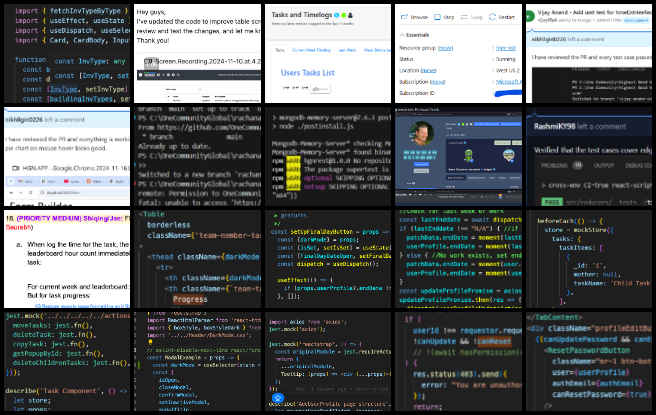
REACTONAUTS SOFTWARE DEVELOPMENT TEAM
Reactonauts’ Team’s summary, covering their work on the Highest Good Network software, was managed by Vijeth Venkatesha (Software Engineer) and includes Dhairya Mehta (Software Engineer), Gmon Kuzhiyanikkal (Software Engineer), Haoyue Wen (Software Engineer), Khushi Jain (PR Team I-N), Mohan Gadde (Software Engineer), Nikhil Pittala (Software Engineer), Pallavi Thorat (PR Team O-Sh), Peterson Rodrigues (Full-Stack MERN Stack Developer), Rishitha Mamidala (Software Engineer), Saniya Farheen (Software Engineer), Sharadha Shivakumar (Software Engineer), and Vikram Badhan (Software Engineer). The Highest Good Network software is how we’ll manage and objectively measure our process for an ongoing path to making no-impact living mainstream through our social architecture, construction, production, and maintenance processes.
This week, team members focused on a range of tasks that contributed to One Community’s ongoing path to making no-impact living mainstream. Dhairya has worked on enhancing the “Find User” function in the Projects section by identifying root issues and developing a sort and search feature to improve user assignments. Gmon completed work on adding active/inactive team numbers on the team page and submitted PR 2850 for review. He began addressing a new task related to bell notifications for task deadlines and encountered a 404 error in the process. Haoyue made significant progress on the FAQ tool and implemented a structured database with search functionality, an admin management page for tracking FAQs, and permissions settings. Khushi updated the Phase 3 document by resolving comments and incorporating feedback. She equally collaborated with Jae and Yash for approvals.
Mohan documented an issue with the project archive functionality, where the interface froze after setting a project to inactive. He indicated a need for further investigation in the ongoing path to making no-impact living mainstream. Nikhil reviewed 12 pull requests across front-end and back-end tasks and performed unit testing to ensure code quality and functionality. Pallavi has submitted a pull request for a previous task and began addressing a bug in the Admin Dashboard’s deadline check-in functionality. She focused on backend interactions to resolve the issue. Peterson enhanced the “Team Code” input with autosave functionality and streamlined the process. He also improved the user experience to enhance the ongoing path to making no-impact living mainstream.
Rishitha completed the active filter for the project page and raised a pull request. She began working on a percentage toggle for the People Report. Saniya implemented changes on a teammate’s dashboard and resolved functionality issues around the ongoing path to making no-impact living mainstream. She continued bug investigations for future updates. Sharadha addressed freezing and visibility issues in the Team Member Tasks section and tested updates across roles and screen modes, while debugging a screen shake issue on smaller displays. Vijeth supported the team by addressing website load time issues and gathered updates in weekly meetings. He resolved ongoing team challenges. See the Highest Good Society and Highest Good Network pages for more on how this relates to the ongoing path to making no-impact living mainstream. Below is a collage of the team’s work.
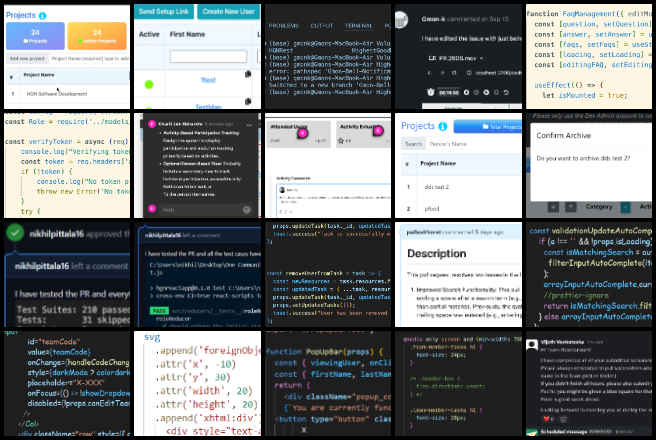
SKYE SOFTWARE DEVELOPMENT TEAM
Skye Team’s summary covering their work on the Highest Good Network was managed by Rishabh Rao (Administrator) and Luis Arevalo (Software Engineer) and the team includes Laura Cohen (Software Engineer), Sai Preetham Dongari (Full Stack Developer), Snehal Dilip Patare (Software Engineer), Yao Wang (Software Engineer) and Zhimin Liang (Full Stack Developer). The Highest Good Network software is how we’ll manage and objectively measure our process creating an ongoing path to making no-impact living mainstream through our social architecture, construction, production, and maintenance processes.
This week, Laura worked on troubleshooting issues with the permission change modal by refining the process for filtering permissions for users and preset roles on an ongoing path to making no-impact living mainstream. She encountered challenges due to incomplete back-end logic for front-end permissions, which led her to explore alternative methods for retrieving and applying permissions for the current user. Yao continued developing a LinkedIn alternative, adding media upload functionality to the front end to support posting media. While addressing a persistent 401 error, he tested the issue using curl and replaced the environment file with a directly embedded token in the backend code, though the error remained unresolved. Snehal created a branch named Snehal_delete_0members_from_project and submitted PR#2862, which faced a failing test due to an issue with the delete button on the member’s page. She also started addressing a User Management bug to fix the table layout and reduce the size of the Role column executing the ongoing path to making no-impact living mainstream.
Zhimin worked on the backend code for her local environment, defining routes to handle requests for scheduling and posting videos, implementing functions for scheduling posts and uploading videos to YouTube, setting up the Express server in the app.js file, and connecting it to MongoDB. She did not complete her hours and plans to begin working on frontend code locally. Sai Preetham addressed a name alignment and truncation issue in the ongoing path to making no-impact living mainstream; summarybar.jsx and summarybar.css files as part of the HGN Software Development project. He implemented code changes, tested various scenarios, raised a Pull Request (PR) with descriptions and reproduction steps, reviewed PR suggestions for previous assignments, searched for new tasks, awaited feedback from Jae on ongoing items, and completed updates related to the weekly summary and Dropbox tasks.
Luis worked on creating new warnings and addressed issues with the route for fetching special warnings, which was not functioning correctly or returning the appropriate warnings. After debugging, he was able to complete and post new warnings triggered by the buttons in the ongoing path to making no-impact living mainstream model. He plans to finalize the functionality of the remaining button, ensuring both buttons work as intended. Additionally, he ensured that clicking the button displayed the modal, replicating the behavior of issuing a warning when a user received more than three warnings. See the Highest Good Society and the Highest Good Network pages to learn more about how their work contributes to the ongoing path to making no-impact living mainstream. See below for some of the work done by the group.
SOFTWARE PR REVIEW TEAM A-K
The PR Review Team’s summaries for team members’ names starting with A-K and covering their work on the Highest Good Network software were managed by Anoushka Hazari (Data Analyst) to achieve the ongoing path to making no-impact living mainstream. The Highest Good Network software is a foundation of what we’ll be using to measure our results for the ongoing path to making no-impact living mainstream. This week’s active members of this team were: Abdelmounaim Lallouache (Software Developer), Anjineyulu Annavarapu (Software Developer), Audrey Trinh (Software Engineer Intern) and Carl Bebli (Software Engineer). They reviewed all the Highest Good Network PRs (Pull Requests) shared in this week’s update. Learn more about how the Highest Good Network will measure and assist in the ongoing path to making no-impact living mainstream in the Highest Good Network open source hub. The collage below shows a compilation of the work from this team.
SOFTWARE PR REVIEW TEAM L-Sg
The PR Review Team’s summary for team members’ names starting with L-Sg and covering their work on the Highest Good Network software was managed by Saumit Chinchkhandi (Administrative Assistant and Software Engineer). The Highest Good Network software is a foundation of what we’ll be using to measure our results of the ongoing path to making no-impact living mainstream. This week’s active members of this team were: Nahiyan Ahmed (Full Stack Software Developer), Nathan Hoffman (Software Engineer), Pratyush Prasanna Sahu (Software Engineer) and Samarth Bhadane (Software Engineer). They reviewed all the Highest Good Network PRs (Pull Requests) shared in this week’s update. Learn more about how the Highest Good Network measures and assists in the ongoing path to making no-impact living mainstream in the Highest Good Network open source hub. The collage below shows a compilation of the work from this team.
SOFTWARE PR REVIEW TEAM Sh-Z
The PR Review Team’s summary for team members’ names starting with Sh-Z and covering their work on the Highest Good Network software was managed by Olawunmi “Ola” Ijisesan (Administrative and Management Support) and Samarth Urs (Administrative Assistant and Data Analyst). The Highest Good Network software is a foundation of what we’ll be using to measure our results of an ongoing path to making no-impact living mainstream. This week’s active members of this team were: Sujith Reddy Sudini (Mern Stack Developer, Full Stack Developer, Software Developer), Neeharika Koniki (Software Engineer, Developer), and Yiyun Tan (Software Engineer). They reviewed all the Highest Good Network PRs (Pull Requests) shared in this week’s update. Learn more about how the Highest Good Network will measure and assist in the ongoing path to making no-impact living mainstream in the Highest Good Network open source hub. The collage below shows a compilation of the work from this team.
AND WE PRODUCED THIS WEEKLY UPDATES BLOG – CLICK HERE TO SUBSCRIBE
FOLLOW ONE COMMUNITY’S PROGRESS (click icons for our pages)
INVESTOR PAGES
GET INVOLVED
DONATE | WAYS ANYONE CAN HELP | MEMBERSHIP
CLICK HERE FOR ALL PAST UPDATES
 One Community
One Community

